

What Does CPS Look for in a Home Visit? [Checklist]
By: Author Nicole Thelin
Posted on Published: May 14, 2020 - Last updated: February 1, 2022
![cps home visit checklist What Does CPS Look for in a Home Visit? [Checklist]](https://lowincomerelief.com/wp-content/uploads/2020/05/AdobeStock_273516920-scaled-1-720x405.jpeg)
If you’re dealing with CPS, you’ve probably wondered, “What does CPS look for in a home visit?” I have been visited by CPS a few times, and it’s always stressful… but I’ve done some research and figured out what CPS is actually looking for when they visit your home.
Before we begin, I need to remind you that I am not a lawyer or social worker. I am a journalist with extensive CPS experience. I have written and reported on this topic several times in the past. If you need advice about your specific situation, I’ve aggregated a list of free legal aid help here .
Wait – do you know your rights?!
When CPS comes knocking, you have rights. Make sure you know what they are, because this is definitely one of those things that you need to know before CPS shows up at your house.
For example, if the caseworker does not have a warrant, you do not have to let them in. You can refuse entry. You can find more information about this in our other articles, “ What CPS Can and Cannot Do ” and “ What are my rights with Child Protective Services? “
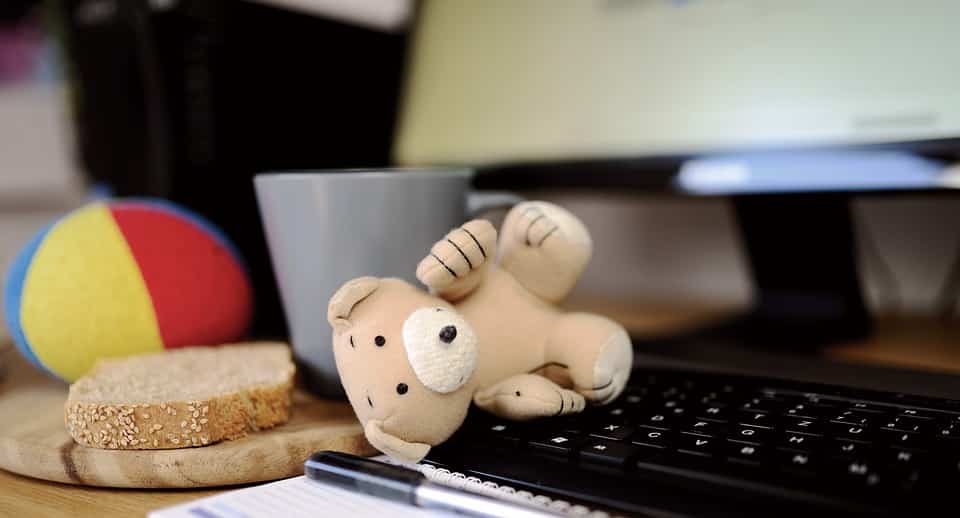
What does CPS look for in a home visit?
To find an answer to this question, we turned to federal and state publications . There are many theories surrounding this topic, but we wanted to know actual, factual truth from the source.
So, according to a variety of state and federal laws, regulations and handbooks, here is the answer to “what does CPS look for in a home visit?”
Remember, the overall goal is to determine whether or not a child is safe at home. These things are just specific benchmarks that help them make that determination.
Cleanliness
Cleanliness was always my primary concern when CPS was called on me. However, I was repeatedly assured by caseworkers that I had nothing to worry about. They are more concerned with ensuring sanitary conditions than a sparkling clean living environment, so you can breathe easy. Life with kids is messy, and CPS knows that.
Hopefully, like me, you’ll be relieved to know that perfection is not the answer to “What does CPS look for in a home visit?”
CPS looks for human and animal feces in the home. Unfortunately, they sometimes find it.
Infestations
Insect and rodent infestations are generally considered an indicator of unsanitary living conditions. This isn’t always the case, of course, but it is something that CPS will look for in a home visit.
Rotten Food
Rotten food is something that CPS caseworkers are trained to look for during a home visit.
Piles of dirty laundry are not good. Laundry piles should be avoided altogether. If you must have piles of laundry, piles of clean laundry are far preferable.
One of the answers to “What does CPS look for in a home visit?” is actually what they smell. The smell of your home can tell someone a lot about how clean it is on a regular basis. Even if it looks clean, a lingering odor can betray past negligence.
Tidiness is important. If a house is tidy, it will usually be clear of tripping or choking hazards. It will also be free of clutter that could pose a danger if a fire or other emergency were to happen.
There should not be any trash in the house. Trash is a major red flag for CPS caseworkers.
CPS will look for running, clean water because this is considered a sanitary need. They will check for flushing toilets and other functional utilities.
Safety Hazards
There are many types of safety hazards that CPS looks for in a home visit. This is probably the most important answer to “What does CPS look for in a home visit?”
Burn Hazards
Do you know the temperature of your hot water? CPS may check the temperature to ensure that your children are not in danger of scalds or burns.
Choking Hazards
Small objects left in the reach of very young children can present a choking hazard. CPS will take note of any risks that are present in your home.
Drug Paraphernalia
Any drug paraphernalia is a red flag. Second-hand smoke in the home is also something that CPS will pay attention to, especially if the children have asthma or other lung problems.
Environmental Danger
Sometimes, older and cheaper homes can be quite dangerous. Exposed wiring, broken appliances , shattered glass and even dangerous neighborhoods can pose extra risks to children. Broken outlet covers could also be a problem.
Be mindful of anything that could pose a trip hazard, fall hazard, electrical hazard, or any sort of safety hazard. CPS will take note of all these things during a home visit.
The good news is that the agency may be able to provide help fixing many of these issues. They may be able to provide funding, negotiate with landlords or provide resources to help you remedy some of these problems.
Fire Hazards
Are any doors or windows permanently blocked or closed? If so, that may pose a danger in case of a fire or other emergency. This is something that will always get a caseworker’s attention.
They will also want to know if the smoke alarms work. After all, when it comes to “What does CPS look for in a home visit?”, safety is the ultimate answer.
Guns & Weapons
If guns and other weapons are accessible to children, that’s a major problem. Weapons should be stored in a locked cabinet, out of reach and inaccessible to children. Firearms should not be loaded and ammunition should be stored in a separate location.
Chemicals & Cleaning Products
Many household cleaners, medications and home improvement products can be poisonous. They need to be stored safely out of reach of children. It is recommended to keep medications (including over-the-counter medications) in a locking cabinet.
Other safety hazards
Other general safety hazards will be searched for as well. These may include things like stairs without gates, lack of safety restraints in your vehicles, etc.
Many families are surprised to learn that when it comes to “What does CPS look for in a home visit?” the answer is always “sleeping arrangements.” Even if your complaint has nothing to do with a child’s sleeping arrangement, this issue will most likely be addressed by your caseworker.
Children under the age of 18 months should sleep in a crib, free of blankets, pillows, stuffed animals, bumper pads and other materials.
Any bunk beds must have railings on both sides of the upper tier to prevent falls. Children who are sleeping in the top bunk should be old enough and mature enough to do so safely. Generally, no child under the age of six years old should sleep in a top bunk.
Co-Ed Roommates
CPS generally does not approve of boys and girls sharing a bedroom after the age of five years old. If there is any way to avoid that, it should be avoided.
Does the child have adequate clothing ? Is their clothing clean?
Personal Possessions
As they check the child’s room, they’ll see the child’s sleeping arrangements, bedding, toys, and other possessions. These are all considered indicators of whether or not a child is well cared for.
The child must have a safe place to sleep. Generally, alternatives like closets and hallways are not considered safe bedrooms because each bedroom should have a window that can open in case of an emergency.
The kitchen plays an important role in every family’s life. It shouldn’t be a surprise that CPS takes a special interest in this space.
CPS will want to see that you have food in the house, and that the food is available to your children. The refrigerator should be clean and well-stocked. The pantry and/or cupboards should have food. There should not be a lock on the kitchen door, fridge or cupboards that would prevent the child from accessing food if the child is hungry.
They will want to make sure that there is no rotting food in the kitchen.
They will also want to make sure that there are no unsecured knives or other dangerous objects within reach of the children.
If you’re worried about “what does CPS look for in a home visit?” and you have pets, then you have a few extra things to consider.
Litter boxes, shedding fur and other pet-related messes will be a cause for concern with the caseworker. If your pet is indoors, make sure that the pet’s messes are taken care of.
Fleas/Ticks
CPS will want to know if your pets are well cared for. If you allow your pets to have an infestation untreated, it will reflect poorly on your caregiving.
There are some dangers that can exist outside your home, also. If you are renting an apartment, these aren’t necessarily things you need to worry about. If you’re in a home, however, we need to add these things to the list of “What does CPS look for in a home visit?”
Road Safety
If the home is located near a busy road, the yard should be adequately fenced to keep small children safe from getting into the road.
Water Features
If a pool or water feature is present, it should be fenced or gated so that younger children cannot fall in.
Don’t make these 5 mistakes with CPS!
Nicole thelin.
Nicole is the founder and lead researcher of Low Income Relief. After a personal experience with poverty and homelessness following her husband's sudden medical discharge from the U.S. Army, Nicole discovered the life-changing impact of community resources. This experience ignited her passion for empowering others to navigate similar crises. Nicole launched her writing career at age 16, working for various newspapers and publications. Her commitment to in-depth research and accessible content has been recognized by Google for Publishers and other industry leaders. For over 20 years, she has applied her investigative skills to uncover the most helpful, up-to-date information on benefits programs and community resources, ensuring Low Income Relief maintains the most extensive resource databases available.
CPS Home Visit Checklist
Our free CPS Home Visit Checklist promotes healthy child well-being and enhances safety. Read the complete guide now and download the template.
.jpg)
By Ashleigh Knowles on Apr 08, 2024.
Fact Checked by RJ Gumban.
.jpg)
The Brief Cognitive Assessment Tool (BCAT)
The Brief Cognitive Assessment Tool (BCAT) is a structured instrument developed to evaluate cognitive function, cognitive skills, and cognitive impairments across various domains. This tool is particularly valuable in the context of assessing individuals for potential cognitive impairment , dementia, or other cognitive disorders. The BCAT encompasses a range of cognitive domains, including memory, attention, language, executive function, and visuospatial skills, offering a well-rounded evaluation.
One of the distinctive features of the BCAT is its efficiency, allowing for a comprehensive cognitive assessment within a relatively short period. This makes it particularly useful in various healthcare settings, including primary care, geriatrics, and neurology. The instrument is designed to be user-friendly, facilitating ease of administration by healthcare professionals, including physicians, nurses, and other trained staff.
The BCAT incorporates evidence-based practices in cognitive assessment, drawing on established principles in neuropsychology and geriatric care. It takes into account the multifaceted nature of cognitive function and the importance of early detection of cognitive disorders. The comprehensive nature of the BCAT enables practitioners to identify specific areas of cognitive strengths and weaknesses, guiding subsequent interventions, care planning, and support strategies.
Printable CPS Home Visit Checklist
Download this CPS Home Visit Checklist to evaluate cognitive function, cognitive skills, and cognitive impairments across various domains.
What does the BCAT Test assess?
This multi-domain cognitive assessment tool addresses key cognitive domains, providing a comprehensive overview of an individual's cognitive abilities.
- Orientation: The BCAT assesses an individual's orientation, including awareness of time (date, day of the week, year), place (current location, city, state), and person (own name, age, birthdate). This foundational domain gauges basic cognitive orientation and awareness.
- Attention: The tool measures attention by evaluating the ability to focus, maintain concentration, and selectively attend to specific information while disregarding distractions. Tasks may include repeating numbers forward and backward, subtracting numbers serially, and visually scanning for specific targets.
- Memory: BCAT assesses both immediate and delayed verbal recall and visual information. Tasks may involve learning and recalling a list of words or a story, as well as copying and later reproducing a geometric figure.
- Language: The language domain evaluates various aspects of language comprehension and expression, such as naming objects or pictures, following verbal instructions, repeating sentences, and generating words within a given category.
- Visuospatial skills: This domain assesses the ability to perceive and manipulate visual information, including tasks like copying a complex figure, drawing a clock, and identifying overlapping shapes.
- Executive functioning: BCAT evaluates higher-order cognitive abilities involved in planning, organizing, problem-solving, and decision-making. It may assess mental flexibility, abstract reasoning, and the inhibition of impulsive responses.
When to administer the BCAT Test
Screening for cognitive impairment:
- Used as a shorter version screening tool to identify individuals who may have cognitive impairment and warrant further evaluation. This is particularly relevant to those who are trying to track cognitive ability and other cognitive impairments, especially in aging mental health care.
- Often administered in primary care settings, memory clinics, or during geriatric assessments.
Tracking cognitive changes over time:
- Administered serially to monitor cognitive function and detect any decline or improvement over time.
- Used to track the progression of cognitive disorders or assess interventions' effectiveness.
Evaluating cognitive function in specific populations:
- Used in research studies to assess cognitive function in various populations, such as older adults, individuals with neurological disorders, or those undergoing medical treatments that may affect cognition.
Assessing cognitive function in clinical settings:
- Used in various clinical settings, including:
- Hospitals: To assess cognitive status after a stroke, head injury, or other neurological events.
- Rehabilitation centers: To evaluate cognitive abilities and guide rehabilitation planning.
- Mental health clinics: To assess cognitive functioning in individuals with mental health disorders.
- Research studies: To investigate cognitive function in various research contexts.
Determining decision-making capacity:
- In some cases, the BCAT score may be used to help assess an individual's ability to make informed decisions about their medical care or financial affairs.
BCAT Test example (sample)
Introducing our BCAT Test Sample at Carepatron, a user-friendly template meticulously designed to provide individuals with a quick and comprehensive cognitive assessment. This accessible template transforms into a detailed documentation record, easily shareable among patients, their families, and healthcare providers.
The BCAT Test Sample evaluates various cognitive domains, including orientation, attention, memory, language, visuospatial skills, and executive functioning. By fostering communication and understanding, this invaluable tool not only identifies cognitive strengths and areas for support but also encourages proactive measures for enhanced cognitive functioning. Embark on a collaborative journey of cognitive assessment and care by downloading the sample test now.
Download this free BCAT Test example here

When would you use this Template?
The CPS Home Visit Checklist Template can help children and minors feel safe and provided for within their home environments. These instances may encompass the following:
- Cases of abuse or neglect : In most reports of child abuse or misconduct in home environments, CPS agents are required to check out the homes to verify the claims. The checklist serves as a standardized framework for CPS workers to work through systematically to allow for consistent quality evaluations.
- Court mandates: In cases of disputes, custody battles, and other legal matters, a CPS home visit may be required. To determine if living environments are in the best interest of the child, it is common to see a CPS visit recommended. The checklist is a robust way to examine the home objectively to help the child and their care.
- Routine monitoring: If there are reports of mistreatment or families are deemed at-risk, CPS visits may be a regular occurrence. Continuous monitoring is a form of preventative care that ensures any problems are quickly identified and addressed to provide the highest form of support for the child.
- Follow-up visits: The CPS Home Visit Checklist can also be used in incidents in at-risk families, where the child has been removed from their home but may be re-entering. The checklist ensures that appropriate measures are being taken for reintegration.
- Callouts of concern: Community members, such as neighbors or teachers, may be concerned about the welfare of a child. In such cases, CPS agents may be called to intervene, where the checklist comes in. The checklist can support CPS workers in these instances, which also helps evaluate whether further steps are needed.
Research & evidence
CPS home visit checklists have strong evidence-based support, making them an essential tool for CPS agents globally.
Extensive research outlines the essential role of checklists in child development, especially in assessing the appropriateness of their home environment. This aids in checking off critical milestones and promoting healthy growth. Not only this, but home visit checklists have proven efficacy when it comes to identifying risk factors such as substance abuse, maltreatment, mental health concerns, as well as domestic violence. Checklists provide a systematic approach to documenting and recording risk factors for higher-quality governance.
Utilizing these checklists also means CPS agents can reduce instances of child abuse and neglect to provide larger-scale support. Rather than subjective decisions being made, checklists allow for a standardized process that enables data-driven decision-making to boost reliability. Checklists can be considered a quality assurance measure that works towards objective assessments that prioritize the welfare of children.
In many cases, these checklists are also a legal requirement across various states and counties, as high systems and institutions regard them as standard compliance when it comes to child welfare and well-being.
Why use Carepatron as your CPS Home Visit Checklist app?
Enhance your healthcare practice with Carepatron’s advanced software! Whether in social work or otherwise, you can work towards a more streamlined workflow that prioritizes your clients.
Improve your communication with team calls, clinical document sharing, and various collaboration features. The best part is that you can access all these and more with just the touch of your phone.
Manage your appointment scheduling easily, and work from our extensive template library to build practical plans in seconds. With our high-tech security, you can also maintain HIPAA compliance without hassle.
Check out Carepatron for easy navigation and a seamless, no-strings-attached interface that can drive your practice and work to success.

Commonly asked questions
A CPS Home Visit Checklist is created by identifying critical assessment areas when evaluating child welfare. Simply categorize all elements with checkboxes and comment sections beside each to allow for precise documentation.
CPS Home Visit Checklists are used in abuse or neglect cases, court mandates, callouts, monitoring, and follow-up appointments. Essentially, any situation where child welfare at home must be examined.
The CPS Home Visit Checklist is commonly used by systematically assessing each section as the agent walks around the child’s home. Each component is checked to see whether it is sufficient, and comments are added. This provides evidence for potential risk management, recommendations, or immediate actions.
Related Templates
Social Worker Home Visit Checklist
Make visits to your client’s home less daunting and more doable with our easy-to-use and well-designed social worker home visit checklist.
Popular Templates
Patient Registration Process Flowchart
Streamline your patient registration with our easy-to-follow flowchart template, designed for healthcare professionals to enhance efficiency and patient care.
Fever Nursing Care Plan
Carepatron's free PDF download provides a template for nursing care planning. It helps you understand the nursing diagnoses associated with fever and how to provide adequate care for patients.
Migraine Treatment Guidelines
Learn effective Migraine Treatment Guidelines to relieve debilitating headaches and improve your quality of life.
Thigh Thrust Test
Learn about the Thigh Thrust Test, a diagnostic tool in healthcare to assess hip joint pathology and potential causes of hip pain.
Balance Exercises for Seniors
Improve your balance and stability with these effective balance exercises for seniors. Download Carepatron's free PDF with examples and enhance your overall well-being today.
Nursing Diagnosis for Pneumonia
Explore our comprehensive guide on nursing diagnoses for pneumonia, including symptoms, treatments, and how our free template can enhance patient care.
Disturbed Thought Process Nursing Care Plan
Explore our detailed guide and free downloadable template for a Disturbed Thought Process Nursing Care Plan, including diagnosis, interventions, and nursing software solutions. Perfect for healthcare professionals.
Coaching Report Template
Explore our comprehensive Coaching Report Template to streamline your coaching sessions. Download our free full report template and elevate your coaching practice with Carepatron.
Ortolani Test
Learn about the Ortolani Test for detecting hip dislocation in infants, including the procedure, symptoms, and how to use our comprehensive test template.
Bunnell Littler Test
Learn how to perform the Bunnel Little Test for intrinsic tightness. Get a free PDF template and sample here.
Risk for Injury Care Plan
Download Carepatron's free PDF example of a risk for injury care plan to help assess and manage potential risks in healthcare settings.
List of Processed Foods to Avoid
Discover the extensive list of processed foods to avoid for a healthier lifestyle. Download Carepatron's free PDF guide now and take control of your diet.
Medicare Enrollment Period Chart
Get a free Medicare Enrollment Period Chart to help patients understand Medicare enrollment periods. Download the PDF template here.
Ruminating Thoughts Worksheet
Discover effective strategies to manage ruminating thoughts with our comprehensive worksheet, designed for mental health improvement and cognitive clarity.
Meningitis Nursing Care Plan
Access Carepatron's free PDF download of a Meningitis Nursing Care Plan and example to help with a nursing diagnosis for meningitis. Learn how to create an effective care plan for patients with meningitis.
Hypoglycemia Nursing Diagnosis
Learn about hypoglycemia nursing diagnosis and get Carepatron's free PDF download with examples to help you better understand and manage this condition.
Dyslexia Worksheets
Explore our Dyslexia Worksheets for effective reading, writing, and spelling support. Free examples are included for structured learning.
Dialysis Care Plan
Need help creating a dialysis care plan? Download Carepatron's free PDF and example to get started.
Medicare Eligibility Age Chart
Unlock key insights into Medicare eligibility with our detailed age chart and comprehensive guides, perfect for healthcare professionals and the public.
Coleman Block Test
Streamline the process of documentation during a Coleman Block Test with a patient by downloading our Coleman Block Test template today!
Appointment Schedule Template
Streamline scheduling process, optimize time management, and enhance productivity. Organize your appointment schedules with our Appointment Schedule Template.
Osteoporosis Care Plan
Developing an osteoporosis care plan is essential for managing this condition effectively. Download Carepatron's free PDF example to learn more.
Medicare Fact Sheet
Download a free Medicare Fact Sheet for your patients. Learn how Medicare works with our free template.
Antipsychotic Sedation Chart
Discover the essential functions of modern antipsychotic drugs, sedation charts, the benefits of medications, and how Carepatron enhances mental health treatment.
Conversation Skills Worksheet
Level up conversational abilities with our engaging Conversation Skills Worksheet. Practical exercises and goal-setting included. Download for free today!
Contingency Map
Understand and use Contingency Maps for behavior management in therapy, education, and parenting for improved decision-making.
Healthy and Unhealthy Food Worksheet
Download our free Healthy and Unhealthy Food Worksheet to help you identify nutritious choices and balance your diet. It includes a fun plate activity!
Diabetes Treatment Guidelines
Explore comprehensive Diabetes Treatment Guidelines for effective management and improved health outcomes.
Steinman Test
Learn about the Steinman Test, a diagnostic procedure for assessing shoulder stability and potential issues, in healthcare.
Medical Spa Business Plan
Discover how to launch and grow your medical spa with our comprehensive business plan guide. Tips, templates, and strategic insights for success.
PTSD Dissociation Test
Assess PTSD dissociation symptoms with Carepatron's free PDF download containing a test and examples for evaluation. Get insights and guidance on recognizing symptoms.
Medical Billing and Coding Practice Worksheets
Enhance medical billing & coding skills with our practice worksheets! Perfect for training & mastering critical concepts. Start learning today!
CVC Checklist
Discover an essential CVC checklist for efficient business operations. Streamline your processes and enhance productivity with our comprehensive guide.
Massage Therapy Invoice Template
Get access to a free Massage Therapy Invoice Template with Carepatron. Streamline your documentation and invoicing process with our PDF.
Ankle Injury Diagnosis Chart
Learn more about ankle injuries and have a step-by-step guide on diagnosing them with our free ankle injury diagnosis chart template.
Health Triangle Worksheets
Explore and improve your well-being across physical, mental, and social health with our comprehensive Health Triangle Worksheets.
Cholecystitis Treatment Guidelines
Explore our Cholecystitis Treatment Guidelines for managing acute conditions. Download the PDF now.
Schizophrenia Treatment Guidelines
Discover the latest Schizophrenia Treatment Guidelines, including antipsychotic medication, psychosocial interventions, and cognitive behavioral therapy.
Breast Cancer Treatment Guidelines
Explore comprehensive Breast Cancer Treatment Guidelines for informed decisions. Learn about the latest protocols and options for adequate care.
Rheumatoid Arthritis Diagnosis Criteria
Learn about the essential Rheumatoid Arthritis Diagnosis Criteria for accurate identification and timely treatment in healthcare.
Face Sheet (Medical)
Explore the benefits of using a medical face sheet for efficient patient care, including quick patient data access and insurance verification.
Medicare 8-minute Rule Chart
Master the Medicare 8-Minute Rule with our comprehensive chart and guide. Simplify billing for time-based therapy services and maximize reimbursement.
Cataract Evaluation
Streamline your Cataract Evaluation process by using our template for documentation. Download for free today!
Wheelchair Evaluation
Download our Wheelchair Evaluation template to streamlines the documentation process through a evaluation of clients' mobility and seating needs.
Pediatric BMI Chart
Download our Pediatric BMI Chart for a resource that can assist you in assessing and documenting a child's weight status.
Medical Fishbone Diagram
Explore the Medical Fishbone Diagram to identify the causes of healthcare issues with our free PDF template. Streamline problem-solving in clinical settings.
Navicular Stress Fracture Test
Explore diagnosis and treatment for navicular stress fractures with our free guide on tests, symptoms, and recovery strategies.
Triphasic BBT Chart
Discover how a Triphasic BBT Chart can help track fertility and early pregnancy signs. Download our free PDF for insights and examples.
Scaphoid Fracture Test
Explore the essential aspects of scaphoid fractures, including symptoms, risk factors, and treatments. Access our free Scaphoid Fracture Test PDF for better patient care.
Health Anxiety CBT Worksheets
Overcome health anxiety with our CBT worksheets designed to help you understand and manage your fears. Download our free example today.
Female Acupuncture Points Chart
Explore our Female Acupuncture Points Chart for a comprehensive guide on key acupuncture points and meridians to enhance women's health treatments.
Musculoskeletal Examination Checklist
Explore a comprehensive guide on musculoskeletal system examination, conditions, treatments, and FAQs with a free checklist PDF download.
Pain Management Coding Cheat Sheet
Streamline your medical billing and coding for pain management with our comprehensive cheat sheet. Download our free PDF today.
Massage Therapy Business Plan
Creating a massage therapy business plan? Download Carepatron's free PDF to guide you through the process and help you create a successful massage therapy business plan.
Food and Symptom Diary PDF
Track your food intake and symptoms on a symptom-free day with our convenient Food and Symptom Diary PDF report. Monitor your health quickly and effectively.
Newborn Exam Template
Streamline newborn examinations with our comprehensive template, ensuring thorough newborn assessment and care. Download now!
Learning Needs Assessment Nursing
Unleash your full potential! Master nursing skills & knowledge with Carepatron's LNA guide. Boost patient care & career growth.
Hypochondria Test
Explore our guide on illness anxiety disorder: signs, impact, and treatments. Download a free Hypochondria Test to start your journey to better health.
Binocular Vision Test
Carepatron's free PDF download provides a binocular vision test example that you can use to assess your vision. Learn more about binocular vision and how to conduct the test effectively.
PASS Assessment
Explore the use of a specialized test to assess postural control among stroke patients to craft a more targeted rehabilitation plan.
Eden's Test
Discover the significance of Eden's Test in diagnosing thoracic outlet syndrome. Learn how this maneuver aids in identifying neurovascular compression.
Esthetician Business Plan
Crafting an Esthetician Business Plan is crucial for success. Download Carepatron's free PDF to guide you in creating your own professional business plan.
Test for Muscle Weakness
Learn how to determine muscle weakness with Carepatron's free PDF download and example. This resource provides valuable information on assessing muscle strength and functionality.
Healthcare Marketing Plan
Download Carepatron's comprehensive Healthcare Marketing Plan PDF, which helps create a successful strategy that drives patient engagement, trust, and growth for your organization.
Hearing Aid Evaluation
Learn how to conduct a thorough hearing aid evaluation with our free PDF download. This comprehensive guide includes examples and tips for success.
OCD Treatment Guidelines
Navigate through the complexities of OCD with our comprehensive treatment guidelines. Discover evidence-based strategies for effective management.
Behavioral Health Treatment Plan
Explore effective mental health treatment plans with our free PDF template, which is ideal for mental health professionals seeking structured recovery paths.
Classical Conditioning Worksheet
Explore classical conditioning with our worksheet, perfect for students, therapists, and self-learners to deepen their understanding of behavior theories.
Action Planning Worksheet
Maximize project success with our Action Planning Worksheet. Track and measure progress effectively. Download free templates for complete project management.
Pharmacy Technician Worksheets
Unlock pharmacy tech skills with our free worksheets for exam prep, skill refreshment, and practical knowledge. Download now.
Type 2 Diabetes Treatment Guidelines
Get comprehensive guidelines and examples for treating Type 2 Diabetes in Carepatron's free PDF download.
Pain Management Treatment
Discover effective pain management treatments and examples through Carepatron's free PDF download. Learn about various strategies to alleviate pain and improve your quality of life.
Therapy Invoice Template
Our Therapy Invoice Template streamlines billing processes, enhances professionalism, and effortlessly keeps you organized. Download now!
Muscle Test
Discover everything you need to know about muscle testing, examples, and Carepatron's free PDF download to help you better understand this technique.
Pisiform Fracture Test
Learn how to conduct the Pisiform Fracture Test. Get a free PDF template to record results and streamline your documentation.
90-90 Hamstring Test
Learn how to perform the 90-90 Hamstring Test. Access a free PDF template and example here.
Overhead Squat Assessment
Get access to a free Overhead Squat Assessment template. Learn how to perform this test and interpret the results.
Osteoarthritis Diagnosis Criteria
Understand the signs, causes, and effective criteria for diagnosis. Download our free PDF example for a detailed understanding.
Stages of Relapse Worksheet
Download our free Stages of Relapse Worksheet to effectively track and manage signs of emotional, mental, and physical relapse.
Cervical Flexion Rotation Test
Discover the Cervical Flexion Rotation Test for assessing upper cervical spine dysfunction, ideal for diagnosing cervicogenic headaches and neck issues.
Levels of Hoarding Test
Access a resource that will aid you in evaluating a patient's hoarding disorder. Download our Levels of Hoarding Test today!
Antisocial Personality Disorder Treatment Plan
Discover an effective treatment plan for Antisocial Personality Disorder to help individuals manage symptoms and improve quality of life.
Vineland Adaptive Behavior Scale
Learn more about the comprehensive Vineland Adaptive Behavior Scale, which assesses adaptive behaviors in individuals and provides targeted support.
Norton Scale
Learn about the Norton Scale, a tool used in healthcare to assess the risk of pressure ulcers. Understand its significance and application.
Medical Diagnosis Form
This form helps healthcare professionals gather patient information for accurate diagnosis. Download a free medical diagnosis form template.
Authenticity Test
Discover how authentic you are with our Authenticity Test. Uncover your true self, live more authentically, and improve your life satisfaction. Try it now!
IFS Treatment Plan
Download Carepatron's free PDF example of an Internal Family Systems (IFS) treatment plan. Learn how to create a comprehensive treatment plan using IFS therapy techniques.
Beers Criteria Template
Explore the Beers Criteria Template, guiding principles for safer medication use in older adults—essential knowledge for healthcare professionals.
Non-Medical Home Care Assessment Form PDF
Download, print, and fill out our Non-Medical Home Care Assessment Form PDF for thorough evaluation and personalized care plans. Streamline your caregiving process today!
Miracle Question Worksheet
Use a helpful tool when practicing solution-focused therapy to engage and build motivation among clients. Download your free PDF here.
Premenstrual Dysphoric Disorder DSM-5
Explore the criteria of Premenstrual Dysphoric Disorder (PMDD) as outlined in DSM-5, shedding light on panic disorder and its impact on mental health.
AC Joint Test
Explore AC Joint Test procedures, results interpretation, and next steps for managing injuries like AC joint separation and arthritis.
Discover the ins and outs of the PVD Test with our comprehensive guide and template. Learn about its purpose, procedure, risks, and more.
Immature Personality Disorder Test
Assess and understand immature personality disorder with Carepatron's free PDF test and examples. Get insights into this personality disorder and learn more about it.
Stinking Thinking Worksheet
Download our Stinking Thinking Worksheet to help clients challenge negative thoughts and cognitive distortions.
Snapping Hip Test
Gain access to an essential resource, the Snapping Hip Test, to assist you in diagnosing a snapping hip during physical assessments. Download today!
R Worksheets for Speech Therapy
Enhance your speech therapy sessions with R Worksheets, designed to improve articulation skills. Download the free PDF sample today!
Hip Quadrant Test
Learn how detailed records promote quality of care for patients with hip pathologies. Download our Hip Quadrant Test to document the process.
Shame Resilience Theory Template
Download a free resource that clients can use for a more goal-directed approach to building shame resilience.
Disruptive Mood Dysregulation Disorder Treatment Plan
Unlock efficient anxiety care with Carepatron's software, featuring patient management tools, secure communication, and streamlined billing.
Join 10,000+ teams using Carepatron to be more productive
404 Not found

How to Prepare My Home for a CPS Visit. Cronkright Law.
How to prepare my home for a cps visit, contact our lansing cps attorney for legal representation, what social workers look for in home visits.
What does CPS look for during a visit? First and foremost, your house should be tidy . There is no law that requires you to maintain a clean house, but understand that CPS workers pass judgment every day based upon their observations, their beliefs, their training, and their life and professional experiences.
Keep Your Home Free From Hazards
Having said that, your house should also be free from hazards, especially hazards to children.
Common hazards that I see in my CPS cases include:
- Chemical products . Think about all of the stuff we keep in our house that we would not want our children to ingest. So, prescription and over the counter medication should all be put away in locking cabinets if there are young children in the home. Parents should exercise reasonable judgement about what is necessary with older children. Cleaning products are often toxic and need to be secured. Home improvement products such as paint, thinners, solvents and industrial cleaners fall into this category as well.
- Scald hazards . This is important. Do you know the temperature of your hot water? Each year many children are burned from water faucets that are too hot. Make sure your water heater is not set too high. Use a thermometer to check the temperature and make sure the temperature is appropriate for the residents of the house. Don’t make the mistake of thinking your kids are too young to turn the faucet on. Every year, children are burned when parents get distracted and children reach for the hot water faucet. There are plenty of web sites that talk about what the proper temperatures are, but here is a trustworthy source .
- Construction hazards . If you have any exposed studs, uncovered electrical outlets or open floors due to construction or home improvements, you need to take appropriate steps to make repairs. Until repairs are made, rooms with hazardous conditions should not be accessible to children. Think carefully about trip hazards, fall hazards, electrical hazards and any other construction or safety hazard that would be a problem if you had a building inspector in your home.
- Illegal Substances. It should be obvious that a CPS investigator would take action if illegal drugs were found in the home. Any drugs will cause concern, but Methamphetamines may be the worst. This is because the manufacturing process for Meth and some other drugs creates health hazards for occupants of the home. Also, any drug sale activity in a home where children reside is a problem. In some situations, Michigan law allows a court to take jurisdiction over children when there is criminality in the home. If a parent is a card-holding medical marijuana patient, it is important to follow the law strictly regarding growing and securing the plants and product. Also, make sure that the children are never exposed to marijuana and make sure that parents under the influence are not caring for a child.
General Home Considerations
In addition to the issues discussed above, there are some general concerns that CPS may be interested in. Each worker may have their own set of things they look for.
Does CPS Require a Child to Have Their Own Room?
While CPS does not require each child to have their own room, it is necessary that children sharing rooms meet certain conditions.
Here are some common home considerations to keep in mind:
- Refrigerator : Is there food in the refrigerator? Is it clean and appropriately stocked with healthy food?
- Cupboards : Is the pantry adequately stocked for a family of this size?
- Laundry : Are there dirty clothes lying around?
- Pets : Are the pets clean and healthy? Are there fleas or lice? Are there any excrement deposits in the house? When you enter the home, does it smell like animal messes?
- Locks on Doors and Windows : It is a big problem if windows are permanently secured so that they can’t be opened or if doors can be locked from the hallway side so children can be locked in. Not only is this a violation of fire code, it is an unsafe condition that will always get the attention of a CPS worker.
- Electrical outlets : All outlets and switches should be covered by unbroken switch plates and outlet covers.
- Prescription medications : Are they out or put away?
- Beds and bedrooms : Does every child have a place to sleep? Are boys and girls sharing a room? If yes, is it age appropriate? Do the bedroom assignments allow adults in the home to be appropriately discreet? Considering the entire situation, are the children safe from harm when sleeping?
- Trash : Hopefully, there isn’t any in the house.
- Garage and Basement : If children have access to garages, basement, attics or out buildings, they need to be clean and safe.
- Lights and switches : Make sure they all work.
- Smoke alarms : Test them. Make sure they work.
It is generally true that the more things we find wrong, the more we look for things that are wrong. If your house is clean and in order, you are likely to have an easy time with a home visit. If your kids seem to be orderly and appropriate, you will likely have an easy time with a home visit.
Remember to Stay Calm
Take the time you need with your children when a CPS worker is in your home. Don’t get rattled or start yelling at the kids. Do what you need to in order to keep the kids calm. First and foremost, this means keeping yourself calm. Kids will always reflect what they see in their parents so take a deep breath before you open the door.
Contact Cronkright Law for the Guidance You Need
Have more questions about a CPS home visit or investigation? Our priority at Cronkright Law is to protect your best interests and fight to keep your children at home with you. Put our expertise on your side.
Do not hesitate to call our experienced attorneys at (517) 881-4643 for a free, initial consultation!
TRUST CRONKRIGHT LAW TO PROTECT YOUR PARENTAL RIGHTS
404 Not found
Free Social Work Tools and Resources: SocialWorkersToolbox.com
Worksheets, booklets, advice sheets, assessment templates and checklists, story books, videos, guides and workbooks downloads for direct work with children and families
Home » Child Protection Home Visit: Practical Guidance
Child Protection Home Visit: Practical Guidance
(You can download the guidance below in a PDF document here . )
WHEN THERE IS NO ANSWER WHEN YOU KNOCK:
- If the family does not answer the door when you knock, listen to/observe any signs of people being present in the house. If you believe that somebody is in the property and it is safe to do so (beware of dogs), consider whether it is appropriate to shout through the letterbox that you are aware that the family is in the house and are waiting for them to answer the door.
- When possible, have a look in the garden to ensure that the family is not there. If possible, also knock on the back door.
- Call the family on their mobile phone to ask where they are, and to see if you can hear the phone ringing inside the house.
- If nobody answers the door, post a note with details of your next visit.
- If the purpose of your visit is to check whether there has been a breach of an agreement that a specific person does not visit the family home, it is advisable to take a second worker who can observe whether the person leaves the house from a back door whilst you are knocking at the front.
WHEN IN THE FAMILY HOME:
Record details of all people present.
Record details of all people present; this includes people who live in the house as well as any visitors who are there at the time of your visit – ask the visitors for their name and relationship to the family. If the child subject to a Child Protection Plan has regular contact with them, ask for their address and DOB so that you can record them on the system. If the adult visitor regularly cares for the child or stays in the child’s family home overnight, ask for their consent for you to complete a police check on them.
If any unknown person refuses to give you their details, request the details from the parents. If not established, record the description of this person.
Establish the whereabouts of the children subject to a Child Protection Plan who are not at home
If the child who you have come to see is not at home, ask about their exact whereabouts and who they are with. If there are concerns about their level of supervision or you have any concerns that the child might be at risk, ask for evidence of their whereabouts – for example, if the child is said to be with another adult, can you call the other adult and ask to speak to the child on the phone; can the adult who is present take you to see the child; can you call the child on their mobile phone and meet them where they are?
If you do not manage to see the child at home during your visit, arrange to see the child at home within statutory timescales on a different occasion. If you are, however, concerned about the child’s safety or well-being on that day, ensure that you make contact with the child on the same day of your visit – this (depending on the level of your concerns) may be a telephone/WhatsApp video call, pre-arranged later home visit or (when appropriate) arrange a visit by the “Out of Hours” team.
Observe the child/young person
- What’s the child’s physical presentation (appropriateness of clothes, level of hygiene, signs of injury; do they present healthy or ill)?
- What’s the child’s emotional presentation and behaviour?
- What is the child doing during the whole duration of the visit?
- How does the child respond to their family members and other people in the house?
Depending on the nature of the case and concerns, you may need to dedicate some of your visits to conduct more comprehensive observations so you can assess factors such as the child’s attachment to their main carer, the child’s level of development, the family’s functioning, the child’s daily routine etc.
You may find the following tools useful:
- Ages & Stages Questionnaire is a child development screening tool for children aged 2 months to 5 It is widely used by health visitors when assessing children’s development, however, it makes a useful tool to support other practitioner’s observation of non-verbal and pre-school children as well. Print the relevant questionnaire depending on the child’s age and take it with you to the family – observe the child together with their parent(s) and fill it in together. Older siblings often enjoy helping fill in the questionnaire in relation to their younger children too.
- There is also Ages and Stages Social-Emotional Development Screening Tool which looks at how children are doing in areas, such as self-regulation, communication, autonomy, compliance, adaptive functioning, affect, and interaction with people.
- Observations Checklist: Assessing Attachment and Bonding . The checklist outlines what behaviours in children from birth to adolescents and parents/carers an observer should look for when assessing a child’s attachment style.
- Joanna Nicolas in her book ‘Conducting the home visit in child protection’ (and her newer version) recommends that the assessors consider the following:
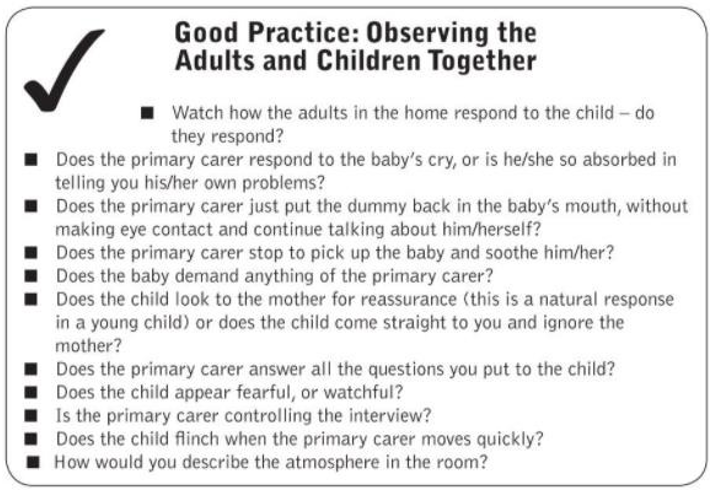
Talk to the child/young person alone
With pre-school children (3 & 4 years), you may first try to establish trust by playing with them in presence of their main carer, then you can ask them to show you their bedroom by themselves. There, if they feel comfortable with you, you can conduct direct work with them, adjusting it to their chronological and mental age. If the child does not feel safe to see you without their parent/carer, you should still conduct direct work in their parent’s presence.
Examples of direct work:
- When in their bedroom, ask the child to show you things in their bedroom – their bed, toys, posters etc. – try to ascertain their likes and dislikes, what they do during the day etc.
- Bring some toys which can facilitate a conversation about what their daily experience is like, for example dolls or puppets, doll house, crafts etc.
- Give the child a sheet with pictures depicting a typical daily routine and ask them to point to those they do every day – depending on their level of understanding/speech, you can then ask more questions about the pictures they point to.
With older children, conduct direct work aimed at establishing what their day-to-day life looks like as well as at ascertaining their views, wishes and feelings
(see www.socialworkerstoolbox.com/category/wishes-feelings-2/ for examples of tools you can use). In addition, focus your direct work on the area of risk/need you have identified.
I n most cases, it is important that you also complete direct work with the child/young person outside the family, e.g. in their school.
See sleeping children
You should see any sleeping child subject to a Child Protection Plan. Only wake a baby in extreme circumstances such as when it is your job to weigh the baby or examine the baby as part of the child protection work. Depending on the level and nature of concerns, schedule another home visit soon to ensure that you see the child awake as well.
Ask if you can hold a baby
Having made eye contact with and cooed at the baby, ask the primary carer if you can hold her/him. Observe how responsive the baby is, whether the baby looks for his/her primary carer for reassurance, whether the primary carer hands the baby over without a care etc. Look out for any physical injuries, eg. observe whether the baby has a limb that hangs awkwardly or whether the baby cries out when you move him/her.
Observe adults & children not subject to a Child Protection Plan
- What is their physical and emotional presentation?
- What are they doing during your visit?
- What is their interaction with the child subject to a CP plan; do they respond to him/her?
- How do they respond to you and other people in the house?
- Are they co-operative, difficult or hostile?
- Pay attention to any areas which have been identified as issues such as evidence of alcohol or drug use, mental health difficulties, domestic abuse etc.
- What is the atmosphere in the house (eg. chaotic, calm and positive)?
- Observe how the animals in the home look and act (there are strong links between the abuse of animals and the abuse of children and women).
Address any identified safeguarding concerns & Child protection planning
Prior to your visit, you should have considered what the purpose of the visit is in terms of making progress in accordance with the Child Protection Plan. Discuss the progress with the parents (and when relevant, the child) accordingly, highlighting both strengths as well as remaining outstanding needs/risks; agree next steps.
If you identify any new safeguarding concerns during your visit, be honest and inform the parents (and when relevant, the child) about them and agree a plan on how the parents/family can address them (this may be agreeing a specific task such as tiding up the kitchen by your next visit or, when more complex, arranging another appointment specifically dedicated to discussing the newly identified concerns).
If you have any immediate and significant safeguarding concerns (such as children presenting with a potential non-accidental injury) and you need to leave the child in the presence of a potentially unsafe adult (eg. when you need to call your manager from your car or speak to each adult in the house separately), arrange for a second worker to come to the house. The second worker can stay with the child and ensure their safety while you are dealing with the issue.
Look around the house & assess home conditions
- See all the rooms in the house.
- Depending on the level and nature of concerns (such as missing children, a suspected person posing a risk in the family home), you may also need to look at places such as basement, garden shed, wardrobes and under beds.
- What are the home conditions like? Ask for consent to take photos to record your concerns/any progress made.
- Look for anything unusual in the physical appearance of the home (such as punch holes in walls which may indicate violence in the house; locks on doors).
- Is there evidence of food in the fridge and cupboards, clean bedding, stock of clean and appropriate children’s clothes, toiletries and toothbrushes, toys etc?
- Depending on the nature of concerns, you will need to investigate the home further– for example, in alcohol abuse cases, additional investigations of alcohol stocks, bins and cupboards will be useful.
- Assess sleeping arrangements for the child.
- If home conditions are a concern, schedule another home visit to conduct a more comprehensive assessment – you may find the Home conditions observation record/framework or the Risk assessment
Child answering the door/at home without a safe supervisor
There is no legal age that a child can be left alone – it depends on the child and the circumstances. You need to make a judgement whether it is safe for the child to be left alone or be cared for by their older sibling; you need to call your manager for advice if you are unsure.
If you assess the child being at home by themselves as low risk, rearrange the appointment.
If the child is left at home without an appropriate supervisor and you assessed the child as being at risk of significant harm, you can either wait for a short period of time until their parent arrives (if safe) or call the police (if the child is in immediate danger or there is no indication what time their parent will be back home/the parent has not arrived despite you waiting).
If the child answers the door, stating the parent is in the house, ask them to go and get them while you wait on the doorstep. If they say they cannot get their parent because they are, for example, sleeping and and you have concerns about the child’s well-being or safety, you need to ensure that both parent and child are OK. If you have no concerns for your personal safety, go into the home with the child, calling the parent loudly; if they are in a bedroom, knock on the door loudly, calling their name until they wake up. If you have concerns for your personal safety, ring the police and stay there with the child until the police arrive.
Ask for evidence
During the visit, do not rely on self-reported accounts by the family members – ask for evidence. For example, when a pregnant woman tells you that she had made all the practical preparations for the child, ask to see them.
Remember that some parents/carers are known to have gone to great lengths to disguise their neglect and abuse of children. For example, Baby P’s (Peter Connelly) bruises were reported to be purposefully covered in chocolate by his parent/carer to avoid detection. Some parents, especially those misusing substances, are known to give their children illicit or prescribed drugs to keep their children quiet so that they are easier to look after. Co-sleeping practice, which is linked to a higher risk of death, is not uncommon.
Read up on serious case reviews to familiarise yourself with further examples and adjust your investigations and interventions accordingly – you need to be thorough to keep children safe by, for example, asking the adults to wash any stains from their child’s skin, ensuring that you see the child regularly awake, looking for signs of the children’s cots being actually used etc.
FURTHER GOOD PRACTICE ADVICE:
- Read the file before your first speak to other agencies and previous workers.
- Do an assessment of risk in relation to yourself.
- Inform your team where you are going and what time you will be back.
- Conduct both announced and unannounced home visits.
- If you are doing a joint visit, plan with your co-visitor before you go on who will do each task and/or take the lead.
- Before your visit, plan the purpose of your visit.
- Find out if there are any racial/ethnicity/cultural issues and plan your visit accordingly. Book a face-to-face interpreter when required. Save details for a telephone interpreting service to your phone and find out how to use it in advance.
- Be aware of any disabilities or additional needs of the child or family members, and make necessary accommodations, such as using visual aids or providing sign language interpreters.
- Do not discuss any confidential information in front of any visitors in the family home – ask to speak to parents and children alone.
- Be aware of your own biases and attitudes, and strive to remain objective and non-judgmental in your interactions with the family.
- Take notes during the visit, including any observations, concerns, or agreements made with the family, and record them in accordance with your agency’s policy.
FREE PDF DOWNLOAD OF CHILD PROTECTION HOME VISIT: PRACTICAL GUIDANCE
Recommended Free Tools & Resources

Other Free Resources You Might Like
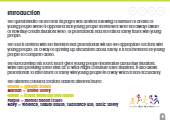
Young people’s safety questionnaire/toolkit
The Young People’s Safety Questionnaire/Toolkit is a valuable resource for professionals working with young people aged 13 to 18. Its purpose is to initiate discussions about safety in a non-accusatory…

Child Sexual Exploitation Educational Videos
The Story of Jay This short animated video, just a minute and a half long, shares a made-up story about a young person who faces sexual exploitation by someone named…

Understanding bipolar disorder booklet
This booklet is for anyone experiencing bipolar disorder. It explains what bipolar disorder is, and how you can help yourself cope. It also explains what kinds of treatment are available, and…

Growing up, sex and relationships information leaflet for disabled young people
This leaflet serves as a helpful guide specifically designed for disabled young people to learn about growing up, sex, and relationships. Whether you’re into team sports, have a passion for…

Videos for kids on conflict, self-esteem, social skills etc
Entertaining and educational videos, games and songs to help young children become better listeners, learn important life lessons and feel good about themselves. Children who learn these skills will grow…

Like us on Facebook
- _Everything
- Adoption & Fostering
- Assessment: Children
- Assessment: Parents
- Assessment: Wishes & Feelings
- Autism & ADHD
- Child's behaviour
- Children & Young people
- CSE, CCE & Sexual Abuse
- Disability & Health
- Domestic Abuse
- Domestic Abuse: Assessment
- Domestic Abuse: Children
- Domestic Abuse: Parents
- Drugs: Adults
- Drugs: Assessment Tools
- Drugs: Children & Teenagers
- Eating Problems & Body Image
- Grief & Loss
- Home safety
- Ilnesses & Disorders
- Imprisonment
- Individual work
- Learning Difficulties
- Mental Health
- Online Safety
- Parenting – Disability
- Parenting Guides
- Personal Safety
- Self-esteem
- Sexual abuse
- Sleep Problems
- Stimulation
- Wishes & Feelings
Copyright © 2024 Free Social Work Tools and Resources: SocialWorkersToolbox.com

844-934-2387
Request Consultation
1 (844) 980-1574
5 Things CPS Looks For During a Home Visit

Legally Protect Yourself During A CPS Home Visit
It’s one of the most stressful things a parent can endure: a CPS visit. You may have one scheduled, or your CPS social worker showed up unexpectedly. The best thing to do during an investigation is to know how to prepare for it.
Even the best parents can feel overwhelmed by a visit from a social worker. Having any stranger come into your home to essentially judge whether or not it’s suitable for your kids is intimidating and stressful. Despite giving your kids everything they need, a social worker might make you feel you’re never doing enough.
Parents should know what social workers are looking for when doing a home visit. This way, the visit will be less stressful, and parents are less likely to make small mistakes. The most important thing that both parents and social workers want is for children to be safe and happy. Here are 5 things CPS looks for during a home visit.
Also Read: How Child Support Affects Your Taxes
How To Prepare For a CPS Home Visit
Prepare yourself to answer some (possibly) uncomfortable questions. Normally if CPS is called, it’s because there’s concerns over a child’s safety. This could mean a bad fight in public with your child to even a neighbour worrying that you can’t pay rent.
Assess the reason or incident that caused CPS to get involved. Take some time to reflect on your personal choices and your parenting tactics. Ask yourself:
- How you do discipline your children
- Is the discipline effective, yet safe
- Do you meet all your children’s needs
- Are there more effective ways for you to conduct these things
Parents are only human. They can make mistakes, just like anyone else, even when it comes to parenting. Take some time to reflect on your home’s safety and your parenting.
Your CPS worker will ask questions about your parenting. Remain claim, even if the questions seem ridiculous like “have you ever hit your child to discipline them?” Be sure to also make note of the last time they were sick, went to the doctor, and what shots they’ve had.
Also Read: What CPS Can And Cannot Legally Do During Investigations
5 Things Social Workers Look For During a Home Visit
Aside from ensuring the family dynamic is stable and safe, your CPS will also look for some other things. Your CPS social worker will need some space and a distraction-free area to speak with you. Make sure you have a space set up for this interview. While interviewing you, your social worker will look for:
The Environment
Have you created a space for you and your CPS social worker to talk distraction-free? This space needs to be relatively clean, and have no distractions like a TV. Your home doesn’t need to be spotless, but it should be tidy before CPS comes. Most importantly, your home should be safe.
Above all, there should be a space for your children. Aside from food, water, and shelter, kids also need to have fun. The social worker will look for some toys, or other items that belong to your kids. Don’t panic if your children’s room is a little messy, the social worker is only making sure they have a livable space in your home.
Other Hazards
Aside from having a clean and livable space, your social worker will also look to see if your home is free of any hazards. Make sure there is nothing that could make your home dangerous. This could mean ensuring wires are tucked away and unused outlets are covered. This also means making sure that things like loose steps are repaired right away. Any trip, fall, electrical, and safety hazards should be taken care of.
Make sure any that could be harmful to your children is safely stored and locked away. This includes:
- Detergents and cleaners
- Pest control products
- Other chemicals
- Power tools and other equipment
- Prescription drugs
- Alcohol
In addition to ensuring that your home is safe, the CPS social worker will also make sure that you have some preventive measures ready. This includes locks on your garage, attic, or basement if they’re unsafe for kids. All the smoke detectors should also work properly, and are you’re prepared for any emergency.
Illegal Activity
There should be no illegal substances in your home. Any liquor or other harmful substances need to be locked away and out of your children’s reach.
In addition to looking for signs of your own personal use of illicit substances, your social worker will also look for signs of creating, buying, and selling of anything illegal.
Basic Needs
Your CPS social worker will look at the condition of your pets. All your pets should be properly fed, bathed, and habituated. A pet can be a tell-tale sign that your home is unsafe. If your pet has ticks, fleas, or there’s signs and smells of animal waste, your home could be seen as incredibly hazardous to your children.
Above all, your children’s basic needs must be met. This means making sure your fridge and pantry is full enough to feed your entire family. Anywhere where food is stored should also be clean and stocked with relatively healthy options. Kids should also have toys to play with and have evidence that they are in school if they’re old enough.
Also Read: Can CPS Take Your Child For Missing School?
Your Relationship To Them As A Parent
For the most part, CPS workers just want to make sure your children are safe and you have a good relationship with them. The social worker will ask some pretty basic questions about what they like and don’t like. Let them know what a normal day looks like for your family, and some ways that you bond with them.
CPS is allowed to speak with your children alone. Be sure to prepare them as well. They don’t need to lie about anything, but they shouldn’t fear the social worker either.
What To Do If Your Kids Are Unlawfully Taken Away
It’s unlikely that a social worker will take your children away upon their first visit. Unless your home presents an immediate danger to your children, it’s rare CPS will take your kids after one visit. However, it can happen if the home puts your kids in immediate danger.
If your home is safe and you feel your case worker judged your situation a little too harshly, you can always call a family lawyer to see how you should proceed. You may have had an off day, or you feel your case worker has discriminated against you. To find a family lawyer near you, call the number at the top of your screen.
Also Read: How To Report An Unethical CPS Worker
*NEW* Want to know more about your legal rights? Follow us on Facebook to keep up with all our legal blogs!
Related Posts

How Child Support Affects Your Taxes
Is Child Support Taxable Your child support is not a taxable or deductible expense. As tax season comes along, many separated and divorced parents question which of their child’s expenses can be...

Can CPS Take Your Child For Missing School?
As a parent, it’s your responsibility to make sure your child gets an education. Failing to make sure your child gets an education is a form of abuse called educational neglect. What is Educational...
Lumiform / Templates / CPS Home Visit Inspection Form
CPS Home Visit Inspection Form
The best welfare of the child is the primary concern of CPS investigators and their agency. When a home visit must be made to parents, many different areas must be checked to properly assess whether the child or children are growing up in a hazard-free and child-friendly environment.
The following digital CPS home visit checklist helps the inspector step by step to take care of all points and to evaluate them according to the requirements of the authority. With Lumiform’s digital tool, there is also the possibility to work with parents on inspection issues that need to be improved. To do this, actions are triggered and time-stamped. This allows CPS investigators to track via the dashboard when a next home visit needs to be conducted to check if failed inspection points have been cleaned up.

Related Categories:
26 templates
Maintenance
439 templates
Workplace Safety
436 templates
Related Checklists:
- Using a CPS home visit checklist to prepare for visits
Other Templates:
- Foster Care Home Inspection Checklist Template
- Packaging Quality Control Checklist
- Irrigation Audit Checklist Template
- Pre Departure Checklist For Vessel
- ANGLETON (979)-267-7660
- SUGAR LAND (281)-944-5485
15 Signs CPS Looks For During An Investigation
- May 27, 2022
- Blair Parker
Child Protective Services ( CPS ) takes its role very seriously in investigating child abuse or neglect reports in Texas. This includes performing home visits when a case is opened or reopened so that CPS can examine the current state of a child’s living conditions.
A CPS caseworker will typically perform a checklist review of the home to help determine the severity of the alleged abuse or neglect . Sometimes, CPS will overstep its bounds to find out more information that they can use against you.
It’s important to understand the signs CPS looks for when performing an investigation to help keep CPS within its boundaries. This way, you can be prepared to defend your family and not give into CPS’ tactics during their home visit.
Let’s explore what a home visit from a CPS caseworker is like and the 15 signs CPS looks for during an investigation.
How Does a CPS Home Visit Work?
A CPS home visit will consist of the CPS caseworker asking questions, looking around your home, and reviewing the allegations in the context of your home environment. A CPS home visit is designed to help confirm the allegations that led to the case being opened. In other words, they are looking to validate the allegations, not disprove them.
This means that a caseworker will look for anything suspicious or unusual that could lead them to recommend removing your child(ren) from home or make another recommendation that could restrict your ability to care for your kids.
Yes, the CPS caseworker is trying to do their job by asking questions and gathering evidence, but the line of questioning could lead you to provide an answer that is not completely accurate and will work against you down the line. That’s why you need to remove emotions from the situation and simply provide straightforward answers without confirming a pre-existing view that the home is not safe for your kids.
For example, if you yell at a caseworker who asks an unnecessarily prying question, that could serve as confirmation that the home is not safe for the children.
One way to remain calm is to understand what CPS is looking for during their visit.
15 Signs CPS Looks For At Your Home
1. Cleanliness. The CPS caseworker will want to ensure that you have created a reasonably clean environment for your children. No, you don’t have to maintain a completely spotless home to qualify as “clean.” However, there should be ample walking and living spaces within the home to ensure that your children can freely move about.
2. Trash . Additionally, CPS will want to ensure that you do not have excessive trash or waste lying around the home that could present health risks to the children. Trash should be kept in a designated trash can or another receptacle.
3. Food. CPS will want to look inside your refrigerator, freezer, cabinets, and other food storage areas to ensure that you have stocked ample food and beverages for your children to be well-nourished.
4. Smells. CPS will take note of any usual smells in or around the home that could point to health concerns. For example, the smell of rotten eggs usually indicates a gas leak in the home. If this has not been dealt with, the caseworker will make notes and ask you questions about what you are doing to address the situation.
5. Interpersonal relationships. The CPS caseworker will want to observe relationships between family members. For example, how do parents and children talk to each other and treat each other? You don’t want to force “good behavior,” as anything that seems unnatural will make CPS even more suspicious. But, you will want to do your best to present a positive family dynamic.
6. Bruises or scratches. CPS will look for any unusual bruises, cuts, or scratches on your children. They will likely ask questions about the cause of the marks to determine whether these marks can be attributed to abuse by another family member or neglect not caring for the safety of your children.
7. Use of drugs or excessive alcohol. CPS will look for signs that there is drug use in the home, and they will also want to know if there is excessive alcohol use in the home that could contribute to violent situations that directly or indirectly impact children.
8. Pets. Are your pets groomed and fed? What kind of behavior are they exhibiting? The CPS caseworker will observe how pets in the home are treated to help them gauge the overall level of care in the home.
9. Insects or rodents. Are there roaches, bugs, or other insects in living areas? Or, are there rodents such as rats or mice roaming around your home? The presence of an unusually high number of insects or rodents could lead to CPS probing further into your living environment.
10. Firearms. Guns should be stored appropriately, locked, and out of reach of children. If guns are in plain sight – especially with the ammunition inside the firearm – then a CPS caseworker will note a concerning home environment.
11. Beds. CPS will want to review current sleeping arrangements to ensure that each child has a dedicated bed or has enough space on a shared bed to sleep comfortably. Additionally, CPS will want to ensure that the beds are properly maintained (e.g., no lice or bed bugs).
12. Chemicals in the home. Are chemicals such as bleach or other cleaning supplies properly stored? CPS will look for signs that chemical products are too easily accessible, leading to a child accidentally consuming these products and becoming violently ill.
13. Notices at the home. CPS will make a note of any notices or overdue bills. For example, if you have a notice on your front door that water will be shut off on a certain date due to a lack of payment, CPS will see this as a sign of being irresponsible to provide basic utilities to children in the home.
14. Pool. If you have a pool at your home, CPS will examine whether you have created a safe environment for children. Or, is the pool too easily accessible without age-appropriate safety features that could lead to an incident?
15. Vehicles. A CPS caseworker may also want to review the inside of your vehicle(s) to ensure that you have proper safety measures in place. For example, do you have car seats appropriate for each child’s age and weight? And are the car seats properly positioned in the vehicle to comply with NHTSA standards ?
– When CPS asks questions about each of these areas – and other areas depending on your specific situation – it’s important to answer clearly and confidently. You don’t want to come across as defensive or like you are trying to downplay a situation.
If you believe that CPS is overstepping its bounds or trying to lead you into making an admission that is not accurate, then consider working with a family law attorney such as myself to provide you with legal support .
Fight Back Against CPS During an Investigation
You don’t have to let CPS walk over your family. You can fight back with an advocate on your side. I will help you form a strong CPS defense so that you can protect your parental rights and your children.
If you are frustrated with CPS or don’t believe that CPS has treated you fairly during an investigation, then call me to discuss your case.
I currently help families in Fort Bend County, Brazoria County, and Harris County defend themselves against CPS in Texas. If you live in one of these counties, don’t hesitate to reach out to me for support.
Call my offices today at 281-944-5485 or 979-267-7660 to discuss what CPS can and cannot do during an investigation. I am ready to support your family during this difficult time!
BY APPOINTMENT ONLY 2245 Texas Dr., Ste. 300 Sugar Land, Texas 77479 (281)-944-5485
BY APPOINTMENT ONLY 104 W Myrtle St., Ste 202 Angleton, Texas 77515 (979)-267-7660

Home Study Checklist
If we can offer three pieces of advice to hopeful adoptive parents starting their home study in Texas, it’s this:
- Stay organized
- Stay ahead of deadlines
- Stay positive
Of these three tips, staying organized might be the most important; it will help you keep track of deadlines, minimize your stress and ensure your home study process goes as smoothly as possible. The following adoption home study checklist can help you start organizing what you’ll need. The home study process can be completed with Adoption Answers in less than one month if you keep at it and stay ahead of deadlines! Remember that you can always call us if you have questions about the home study adoption checklist, or about the process itself.
Whenever you’re ready to begin your home study, you can submit your application . You’ll be able to upload documents online. This step of the adoption process can feel tedious, but stay positive — home studies are important for the protection of children everywhere, and your effort brings you that much closer to the day you welcome your child home!
Here’s what you’ll need:
Document Checklist
Collecting all of this can take a while, so start gathering these now and upload them into your online account. If you have any questions about what documents you might need, or if you’re unclear about anything, contact us and we’ll help you with the documents in your home study checklist.
Gather and submit:
- Your individual autobiographies, describing your life leading up to your decision to adopt
- One photo of the front and back of your house, including the yard area
- A copy of the floor plans for your home, including dimensions and purpose for each room (can be hand drawn)
- 5 reference letters (only one family reference can be used)
- Copies of driver’s license(s) or state-issued ID
- Copies of Social Security Cards
- Birth certificates of all household residents
- Marriage certificate
- Divorce decree(s) (if applicable)
- Employment verification — most recent pay stub, your W-2, a letter from your employer, and/or a non-working spouse statement
- Financial statement
- Most recent income tax return (copy of first page of the 1040)
- Military discharge(s) (if applicable)
- Letter from medical specialist (if applicable)
- Physical examination form for all household members
- Therapy letter (if applicable)
- Proof of insurance for home, health, life, auto, etc.
- Pet vaccination records (if applicable)
- Adoption decree(s) of older child(ren) (if applicable)
- Discipline and Safety Policy Form
- A history of the adoptive parents’ residences over the past 10 years, including length of time at each residence
- An assessment of the available community resources to meet the needs of children
- A telephone number for an entity where it is appropriate for the subject of the study to register complaints about how the pre-adoptive home screening was conducted
Social Worker Home Visit Checklist
People are often most worried about the adoption “home inspection” checklist. There isn’t really an established checklist — rather, you should implement standard child safety measures in your home and show that you’re able to provide a safe, loving, healthy place for a child to grow up. You don’t need to have everything in place by the time your home study professional comes to visit, but it’s good to have some of the basics squared away.
Start child-proofing with this general adoption home visit checklist:
- Working smoke detectors
- Carbon monoxide detector
- Toxic substances (pills, cleaners, etc.) in a locked container or out of a child’s reach
- First-aid kit
- Child-proofed cabinets that are in their reach
- Covered trash cans
- Covered electrical outlets
- Gates for stairs
- Secure screens and locks on windows
- Secure window blind cords out of a child’s reach
- Fire extinguisher
- Set household heating equipment to the appropriate safe maximum limit
- Anchor furniture that might be tipped over (bookcases, dressers, etc.)
- Safety precautions installed on bodies of water (swimming pools, hot tubs, garden ponds, etc.)
- Lock up any firearms and ammunition separately
- Posted list of emergency phone numbers (poison control, your pediatrician, babysitter, etc.)
Clearances Checklist
Safety checks and clearances are conducted in accordance with the Texas Family Code . When you begin the home study process with Adoption Answers, we’ll supply you with the necessary background check forms and give you instructions for obtaining the required clearances.
You’ll need to complete:
- If you have a criminal offense record, such as a DUI, you’ll need to provide additional documentation about the arrest, penalties and probations, treatment classes completed, etc.
- Child abuse and neglect clearances for all household members age 14 and older, listing every state/country you’ve lived in for the past five years (domestic adoptions) or since the age of 18 (international adoptions)
- FBI fingerprinting clearances
- Sex offender clearances
Course Checklist
While this isn’t required by your home study provider, some adoption agencies encourage or require their waiting families to attend certain training courses. You may attend courses that are designed to help meet the specific needs of your future child, or you may be asked to attend courses designed to improve your overall parenting and safety skills.
Suggested courses may include:
- CPR training
- First-aid training
- Parenting classes
- Racial and cultural awareness classes (for transracial adoptions , international adoptions , etc.)
- Adoption-specific classes and more (explore some of our helpful resources )
Remember: While this is a good overview of some of the documents you’ll need to gather and steps you’ll need to take during this process, the requirements can vary and it may not be a complete list for your situation. Your home study worker will provide you with a more detailed home study checklist and can offer additional tips to keep you organized! We’ll be there to answer your questions and help guide you through this process from start to finish.
Contact us at 1 (800) 659-7541 if you have any questions about the Texas home study process, or if you’re ready to begin, you can start your home study application online .
© 2024 Adoption Answers Call 1.800.659.7541

- All Wellness
- All Skin Care
- Moisturizers
- Mineral Sunscreens
- Sunscreens for Kids
- Sunscreens for Dark Skin
- SPF Lip Balms
- Under Eye Patches
- All Hair Care
- Purple Shampoos
- Thinning Hair
- Head Shavers
- Hair Dryers
- All Oral Care
- Electric Toothbrushes
- Toothpastes
- Mouthwashes
- Water Flossers
- Meal Kit Delivery
- Gluten-Free Meal Kit Delivery
- Disposable Face Masks
- Air Purifiers
- Eco-Friendly Laundry Detergents
- Natural Deodorants
- Period Underwear
- All Fitness
- Exercise Bikes
- Walking Shoes
- Fitness Trackers
- Reusable Water Bottles
- Blackout Curtains
- Sound Machines
- Home & Kitchen
- All Home & Kitchen
- Kitchen Appliances & Tools
- All Kitchen Appliances & Tools
- Coffee Makers
- Kitchen Gadgets
- Small Home Appliances
- All Small Home Appliances
- Air Conditioners
- Space Heaters
- Humidifiers
- Bedding & Bath
- All Bedding & Bath
- Bath Towels
- Silk Pillowcases
- Duvet Inserts
- Office Chairs
- Standing Desks
- Desk Organizers
- Seat Cushions
- Under Desk Ellipticals
- All Outdoor
- Raised Garden Boxes
- Garden Hoses
- Beach Towels
- Solar Pool Covers
- Grilling Accessories
- Electronics
- All Electronics
- Wifi Routers
- Gaming Consoles
- Streaming Devices
- Instant Cameras
- Handheld Gaming Consoles
- 3D Printers
- All Headphones
- Noise Canceling
- Wireless Earbuds
- Smart Gadgets
- All Smart Gadgets
- Smart Watches
- Smart Bulbs
- Garage Door Openers
- All Computers
- Gaming Laptops
- Laptops for College Students
- Computer Monitors
- Ergonomic Keyboards
- Dog Carriers
- Litter Boxes
- Scratching Posts
- Cat Carriers
- All Pet Care
- Nail Clippers
- Flea & Tick
- All Luggage
- Lightweight
- Weekender Bags
- Accessories
- All Accessories
- Luggage Tags
- Travel Pillows
- Tech Gadgets
- Packing & Organization
- All Packing & Organization
- Packing Cubes
- Toiletry Bags
- Gift Guides
- All Gift Guides
- Valentine's Day
- All Valentine's Day
- For Any Loved Ones
- Mother's Day
- All Mother's Day
- Last Minute Gifts
- Best Mother's Day Gifts
- For Moms Who Have Everything
- Best from Amazon
- All Graduation
- For College Grads
- For High School Grads
- For Teachers
- Father's Day
- All Father's Day
- Best Father's Day Gifts
- For Dads Who Love Fishing
- Holiday Season & Christmas
- All Holiday Season & Christmas
- Gifts Under $25
- Practical Gifts
- Other occasions & loved ones
- All Other occasions & loved ones
- For Grandparents
- For Bridal Shower
- For New Parents
- For Any Occasion
- Deals & Sales
- All Deals & Sales
- Most Popular This Month
- Sales This Week
- New & Notable
- What to Buy This Month
- All Sleep Week
- Body Pillows
- Sleep Week Sales
- Pet Week 2024
- All Pet Week 2024
- Puppy Checklist
- Kitten Checklist
- Amazon's Pet Day sale
- Dog travel carriers
- CNBC Select
- All CNBC Select
- Credit Cards
- Small Business
- Personal Finance
- Credit Monitoring
- Help for Low Credit Scores
- Sign up for the Select Newsletter
- Check out Shop TODAY
- Privacy Policy
- Do Not Sell My Personal Information
- Terms Of Service
- NBC News Sitemap
Follow Select
14 best travel carriers for dogs, according to editor reviews
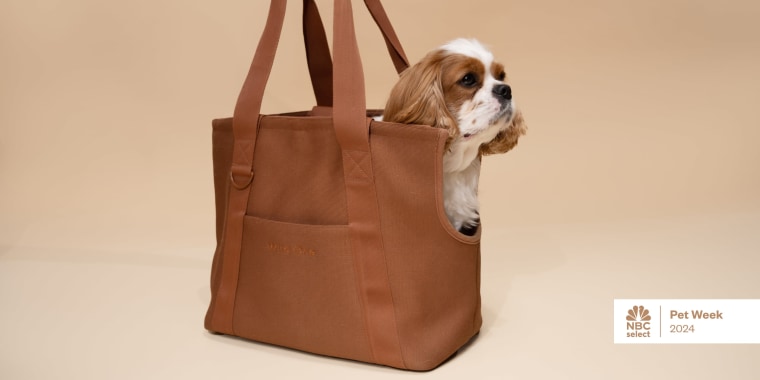
We’re celebrating National Pet Week at NBC Select by sharing our favorite pet products. Shop puppy supplies , kitten essentials and more on our pets homepage .
We all want our dogs by our side as much as possible, and that might include them tagging along on vacations and holiday trips. But traveling with a pet usually involves a range of safety considerations, including gathering the right health paperwork , keeping treats and water on hand and making sure they’re comfortable. Since most airlines and other transportation methods will require taking your dog in some kind of enclosure, the pet carrier you choose is crucial in keeping your dog safe and comfortable.
We spoke to veterinarians, vet technicians and travel safety experts about what to look for in a travel carrier for your dog and how to shop for one that’ll keep them safe. We also compiled a list of carriers either tested by NBC Select staff or recommended by our experts to consider.
SKIP AHEAD Best dog travel carriers | How to shop for a dog travel carrier | How to help your dog feel calm in a travel carrier
Selected. Our top picks

How we picked the best dog travel carriers
When shopping for the best travel carrier for your dog, our experts recommend considering the following factors:
- Size: Pick a carrier that’s big enough for your pet to comfortably stand, sit, lie down and turn around in. The carrier should be as long as the tip of the dog’s nose to the base of the tail, says veterinarian Dr. Kristen L. Nelson . Carriers will usually come in a variety of sizes to fit different breed types (though keep in mind that airline-approved carriers have very specific dimension requirements that will usually only fit small dogs under 20 pounds, according to our experts).
- Materials and build: Carriers are usually soft-sided and made of polyester or nylon, which are easy to clean and water- and tear-resistant, according to our experts. Choose one with mesh sides to provide a good amount of ventilation. Most importantly, you should opt for a carrier that can stand up on its own and not collapse around your pet or deform easily, says Dr. Christina Carlo , a veterinarian and medical director at VCA Avondale Veterinary Hospital. Hard plastic carriers are usually designed for airplane cargo holds, but they’re a safe and durable option for car rides, too, says Carlo.
- Airline requirements: Commercial airlines will usually have certain dimension requirements for carriers that go in the plane’s cabin (with the passenger) and crates that travel in the cargo area of the plane. Most airlines like United Airlines , Jetblue and American Airlines have varying dimension requirements, so be sure to visit their site before traveling.
- Crash testing: Look for carriers and crates that have undergone independent crash testing by the Center for Pet Safety (CPS), which gives your pet the best possible chance of survival if a crash occurs, says Dr. Wendy Hauser , a veterinarian and special advisor to ASPCA Pet Health Insurance.
Best dog travel carriers of 2024
Below are the best dog travel carriers based on experts’ guidance and NBC Select staff experience. We also include top-rated options and key factors to consider, including the carrier’s material, weight capacity and dimensions.
Best overall travel carrier: Away The Pet Carrier
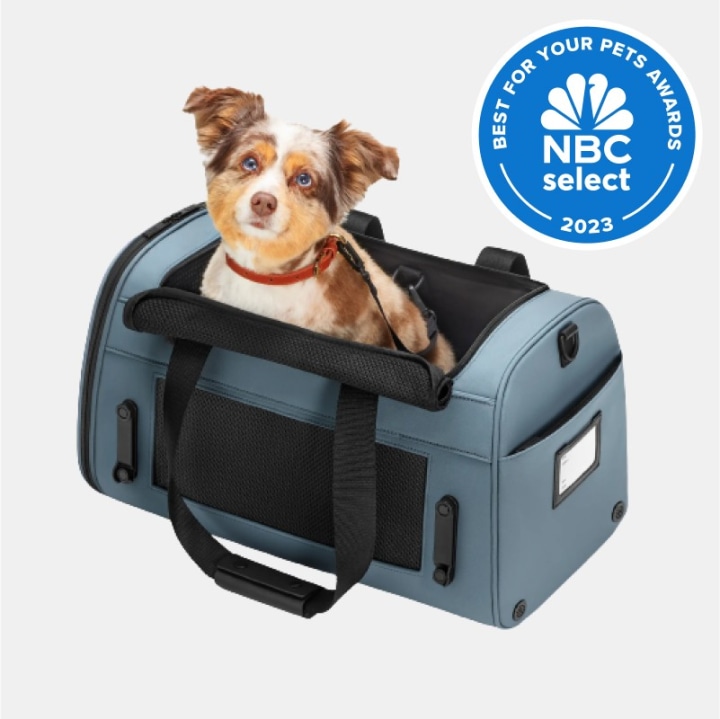
Away Pet Carrier
- CPS certified
- Mesh sides and top
- Removable and washable bedding
- Recommended for smaller dogs
This Away travel carrier, an NBC Select Pet Award for best overall travel carrier, is designed for both car and airline travel. It has zip openings on the top and front with see-through mesh to help your pet see out of the carrier (if you prefer to avoid this, there’s a piece of fabric that rolls down to cover their view).
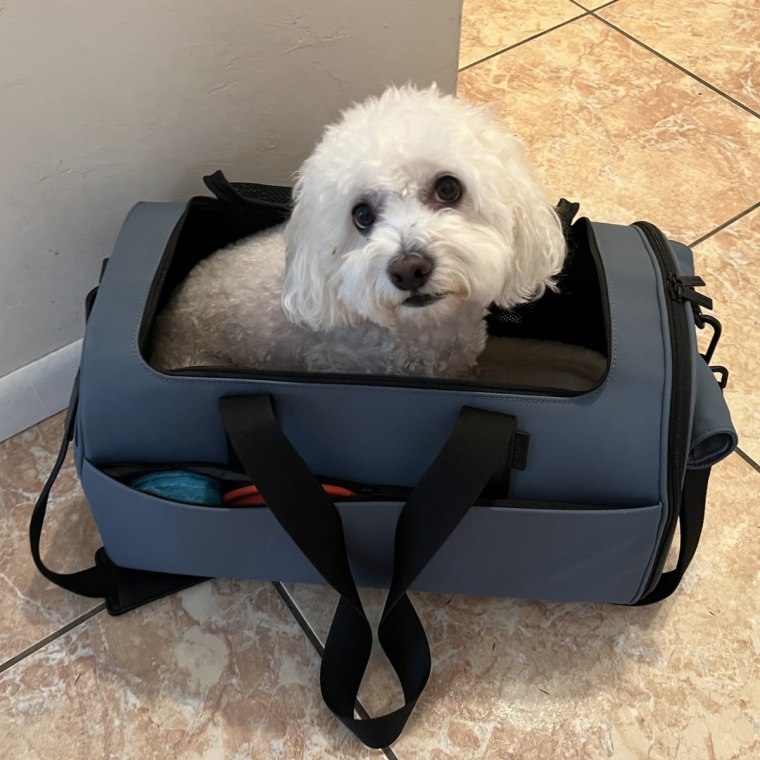
I use this carrier to fly with my 16-pound havanese and bichon frise mix, Bella, because it’s sturdy and makes her feel safe and supported thanks to its durable nylon and leather construction. The mesh gives her enough visibility to know what’s going on outside and helps me keep tabs on her, too. It also comes with machine-washable bedding on the inside that’s soft to the touch, and multiple pockets that keep my belongings and pet essentials accessible during the whole flight. If you’re traveling by car, the carrier has latches on one side that securely fasten to a car’s seat belt system. The Away carrier comes in black and blue colors and you can also personalize it with your initials for an additional $35.
Pet weight: Up to 18 lbs | Dimensions (LxWxH): 18.7 x 10.8 x 10.75 in. | Material: Water-resistant nylon
Best airline-approved carrier: Sherpa Pet Carrier
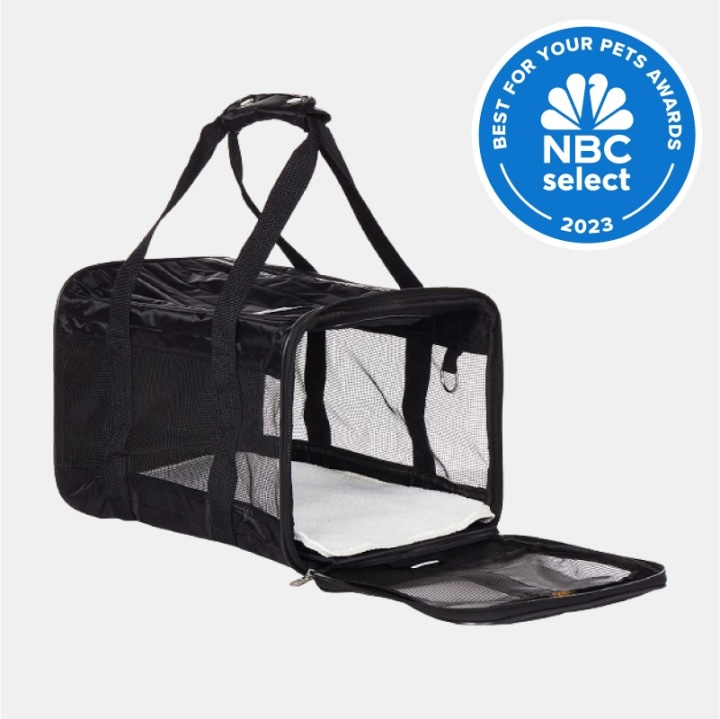
Sherpa Original Deluxe Pet Carrier
- More affordable option
- Very well ventilated
- Removable and washable liner
- Recommended for smaller pets
Another NBC Select Pet Awards winner, this Sherpa carrier is a favorite of CPS founder Lindsey Wolko, who has used it for years to travel with her own pets. She specifically recommends it for air travel because it fits under the passenger seat (it meets the dimensions for most airlines, but always check your specific airline’s requirements before traveling) and has a large zip pocket to store pet supplies like water bowls, leashes and treats. However, it’s not the best pick for car travel because you can’t strap it in using your vehicle’s seat belt system — you’re better off placing it on the floor behind the driver’s seat for safety and to avoid the stitching or zippers to fail, says Wolko.
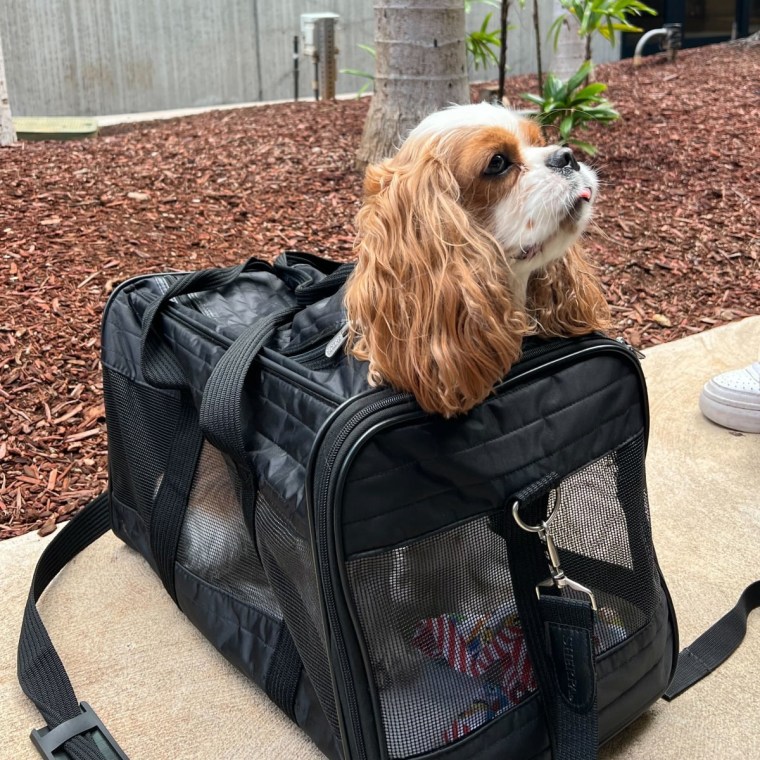
NBC Select manager of editorial operations Shari Uyehara uses this carrier to fly with her 20-pound cavalier King Charles spaniel, Loki, and says it’s a great affordable option. Loki can comfortably shift positions during the flight, and the carrier itself is structured enough to maintain its shape while under the seat, says Uyehara. The sides are made of see-through mesh that allows your pet to easily see out of it. Available in medium and large sizes, the carrier also has shorter top handles and a longer shoulder strap to fit your carrying preferences.
Pet weight: Up to 16 lbs | Dimensions: 17 x 11 x 10.5 in. (medium size) | Material: Polyester and mesh
Best hard-sided carrier for cargo: Gunner Kennel G1
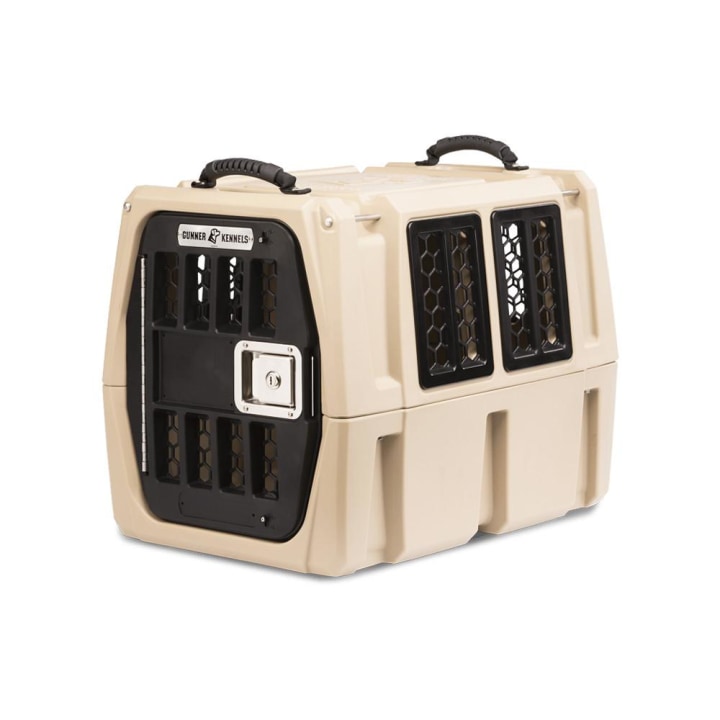
Gunner Kennel G1
- Can't be used as carry-on
This crate earned a 5-star safety rating from the CPS in both the crate and carrier class (the only product to earn a dual certification), and it’s a favorite among our experts. The crate has a thick exterior layer for impact protection, which keeps your pet safe if there’s a crash or a fall, according to the brand. Its reversible door design with an aluminum frame lets you open the crate from either side, and won’t pop open in the middle of a flight, according to the brand. It comes in four sizes — small, medium, intermediate and large — and Gunner offers a size guide that gives recommendations based on your dog’s weight and length.
Pet weight: Up to 30 lbs for small, up to 45 lbs for medium, up to 75 lbs for intermediate and up to 110 lbs for large size | Dimensions: 24.5 x 18.625 x 19 in. (small), 29.5 x 20.5 x 23.5 in. (medium), 34 x 23 x 28.5 in. (intermediate), 40.25 x 28 x 33.25 in. (large) | Material: Reinforced aluminum frame
Best soft-sided carrier: EliteField Soft-Sided Dog & Cat Carrier Bag
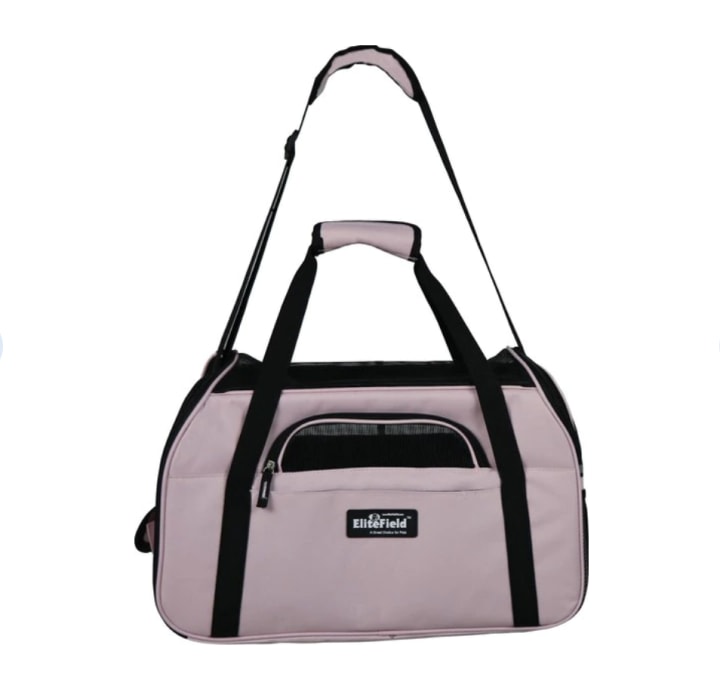
EliteField Soft-Sided Dog & Cat Carrier Bag
At just over two pounds, this is the most lightweight soft-sided pet carrier on our list. It comes recommended by Dr. Amber Karwacki , a veterinarian and partner doctor at Heart + Paw in Callowhill, Pennsylvania, because it has mesh panels on both sides and the front to let air in and prevent your pet from overheating, according to the brand. It also comes with removable and machine-washable bedding and has a back sleeve that attaches to your suitcase, as well as loops that latch onto your car’s seat belt system. The polyester and synthetic build is water-resistant and available in six colors to fit your personal style.
Pet weight: Up to 18 lbs | Dimensions: 19 x 10 x 13 in. | Material: Polyester
Best tote carrier: Wild One Everyday Carrier
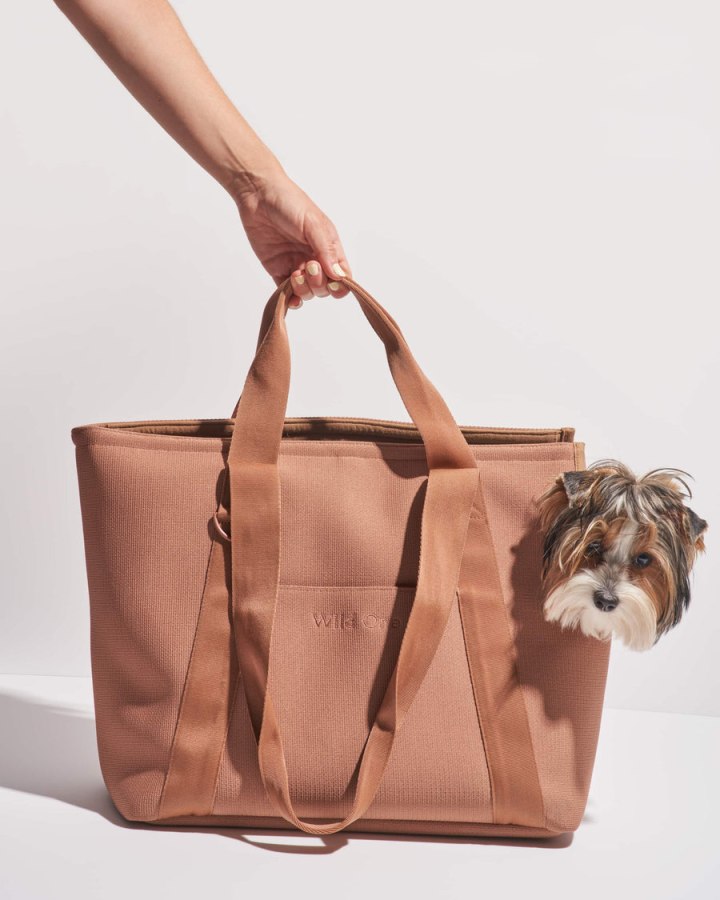
Wild One Everyday Carrier
- Remains open
If you’re looking for a tote to carry your dog around town or on the train, consider this Wild One carrier. This NBC Select staff-favorite option has a small dip in its design, which allows your dog to peek their head out while you carry them around. “I love that Loki’s weight remains balanced in the carrier, but he still has room to move around,” says Uyehara, who appreciates its stability. It also includes a safety clip that attaches to your dog’s harness, ensuring they won’t jump out at a bad time, according to Karwacki (but be sure to never connect this clip to their collar since it poses a choking hazard). It also comes with carrying straps of two different lengths — one for carrying it like a shoulder bag, and shorter straps to carry it by hand. There is a machine-washable mat on the inside and three exterior pockets to hold all your pet’s essentials like bags, treats and toys.
Pet weight: Up to 20 lbs | Dimensions: 21.5 x 7.5 x 14.25 in. | Material: Recycled polyester outer, cotton interior
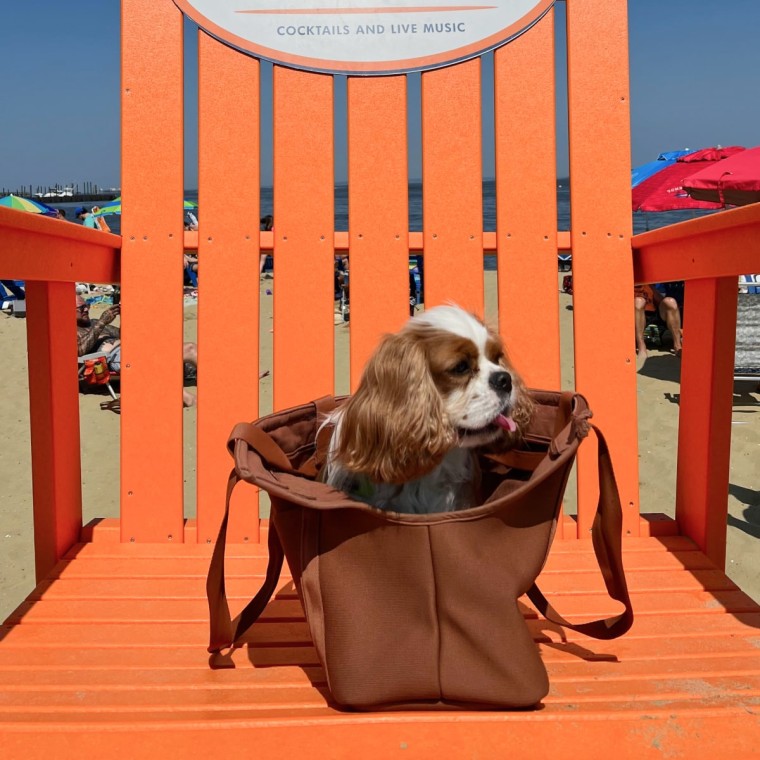
Best collapsible carrier: Roverlund Out-Of-Office Pet Carrier
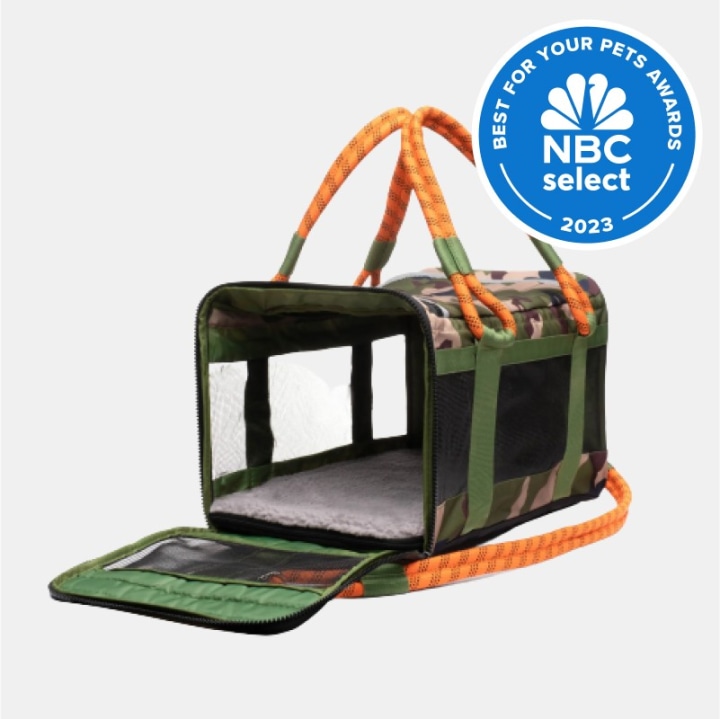
Roverlund Pet Carrier
An NBC Select Pet Awards winner, the small version of this Roverlund carrier is an airline-approved option for both dogs and cats because it’s less than 18 inches long. The straps are all ropes, which our staff found to be more comfortable and supportive than other carrier straps made from typical polyester or fabric. The interior lining is machine-washable and you can also shop the larger version of this carrier for dogs up to 25 pounds.
Pet weight: Up to 20 lbs | Dimensions: 17 x 11 x 10.5 in. (small size) | Material: Water-resistant polyester, mountain climbing rope
Best backpack carrier: Apollo Walker Pet Carrier Backpack
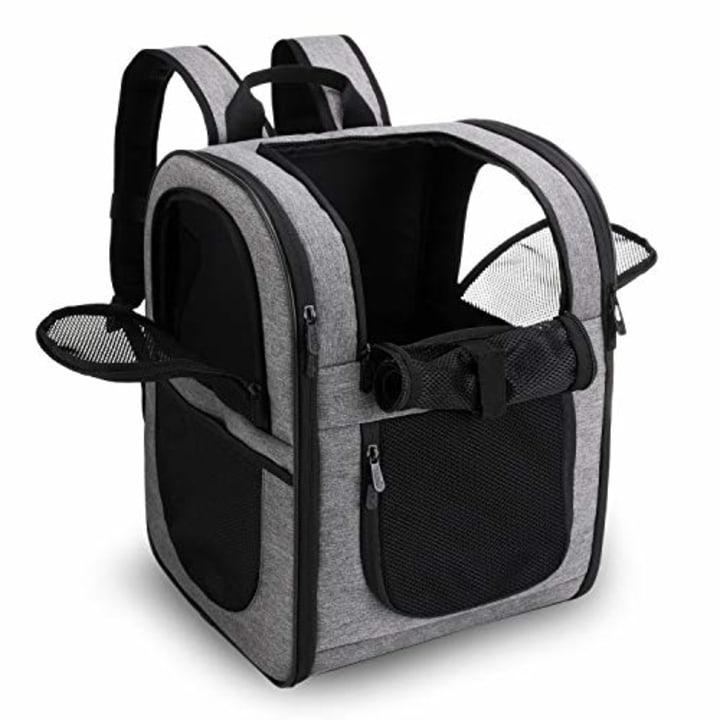
Apollo Walker Pet Carrier Backpack
- Adjustable straps
- Pet can see outside
This highly rated backpack carrier, which has a 4.6-star average rating from over 4,900 reviews on Amazon, has shoulder straps and two separate straps that buckle around your sternum and waist to help evenly distribute the weight of your pet, according to the brand. It has mesh panels on all sides to let your pet see out and comes with removable fleece bedding to keep them comfortable while creating a sturdy base that can hold their weight, according to Apollo. It also comes with a clip that attaches to your pet’s harness to prevent them from escaping or falling out.
Pet weight: N/A | Dimensions: 12.6 x 11.4 x 16.8 in. | Material: Polyester
Best expandable carrier: Midwest Duffy Dog & Cat Carrier
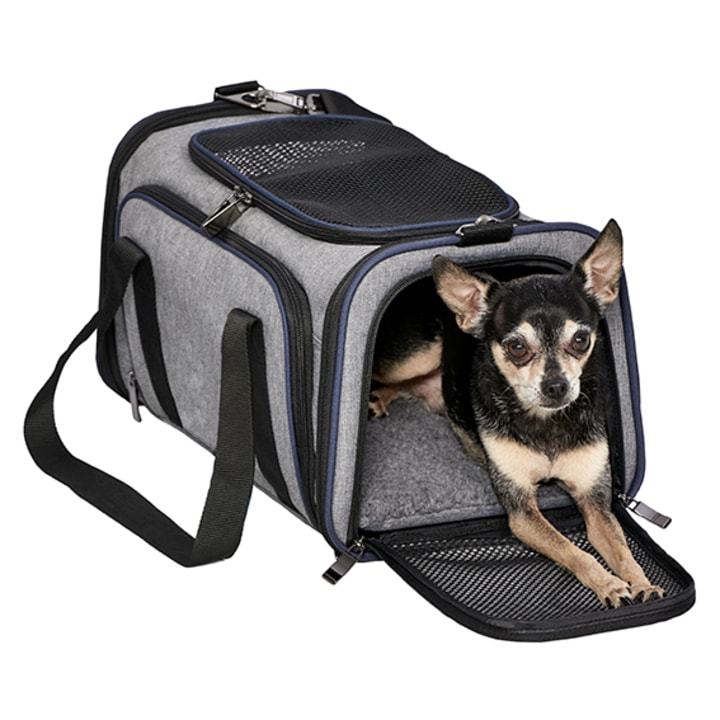
MidWest Duffy Dog & Cat Carrier
- No removable bedding
- Not as ventilated as others
This Midwest Duffy carrier comes recommended by Karwacki because it’s expandable — the mesh sides open up to give your pet more room to move around and stretch their legs. It has two zippered side openings, as well as one on top to make taking your dog in and out easier, according to the brand. It also folds completely flat, so you can store it away when it’s not in use. It comes in three colors and sizes small, medium and large.
Pet weight: Up to 15 lbs | Dimensions: 16.3 x 10.1 x 9.3 in. (small), 18.3 x 11.3 x 11.1 in. (medium) and 19.3 x 12.2 x 12.2 in. (large) | Material: Polyester
Best carrier for medium-sized dogs: Arlo Skye The Pet Carrier
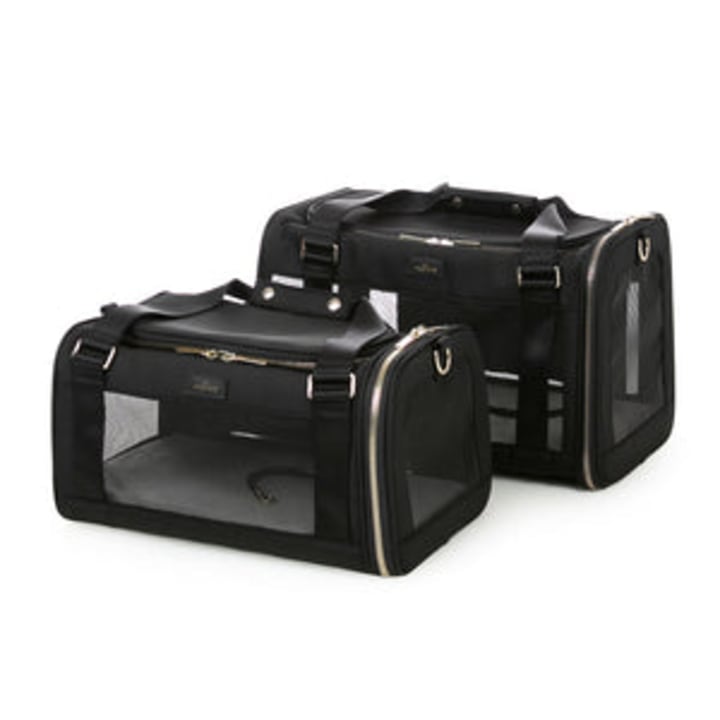
Arlo Skye The Pet Carrier
- No mesh top
This Arlo Skye pet carrier has mesh panels on all sides, making it a well-ventilated option for your pup. It comes with memory foam bedding on the inside that’s both removable and machine-washable, as well as a foldable design you can pack easily in your suitcase or travel bag, according to the brand. It has dual openings on both ends and a back trolley sleeve to place it over your carry-on . The carrier is also highly rated with a 4.9-star average rating from over 60 reviews at Arlo Skye.
Pet weight: Up to 25 lbs | Dimensions: 17.5 x 11 x 10 in. | Material: Poly-mesh and nylon
Best carrier for small dogs: Sleepypod Mobile Pet Bed
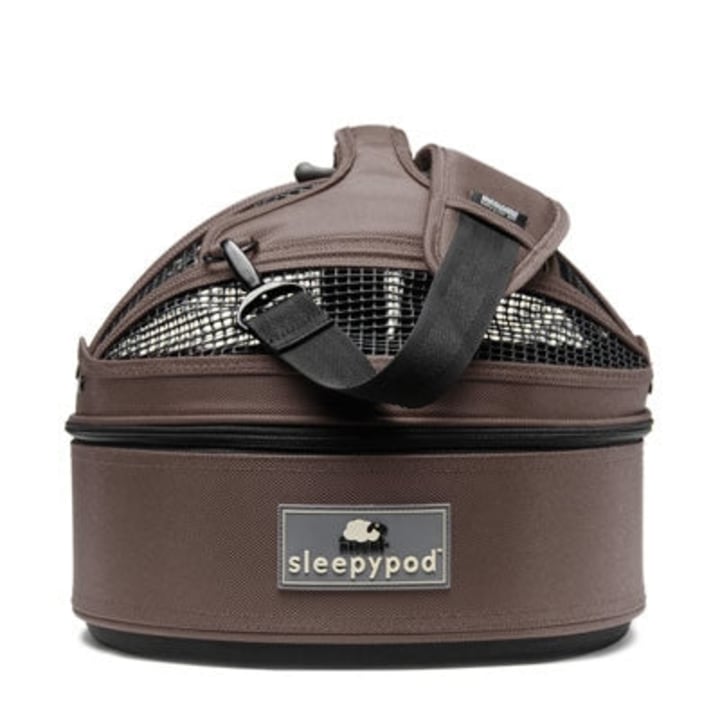
Sleepypod Mobile Pet Bed
The Sleepypod Mobile Pet Bed is an expert-recommended and CPS-certified option that has breathable mesh and a machine-washable interior — it’s built for plane travel for dogs under 15 pounds. Nelson recommends the Sleepypod because it’s easy to carry and gives the pet privacy while traveling since it’s fully enclosed with a mesh panel at the top.
Like several other carriers on this list, the Sleepypod isn’t limited to airline travel: It straps into a vehicle’s seat belt system, so you can comfortably take road trips with your pet. You can also separate the bottom of the carrier to transform it into a bed for your pet, which makes training easier since they can form a positive association with it, says Wolko. The brand’s Sleepypod Atom is another CPS-certified carrier that’s crash-tested for even smaller dogs up to 12 pounds, the lowest weight requirement on this list.
Pet weight: Up to 15 lbs | Dimensions: 17 in. (D) x 6.5 in. | Material: Polyester
Best lightweight carrier: Molly and Stitch Alpine Dog Carrier
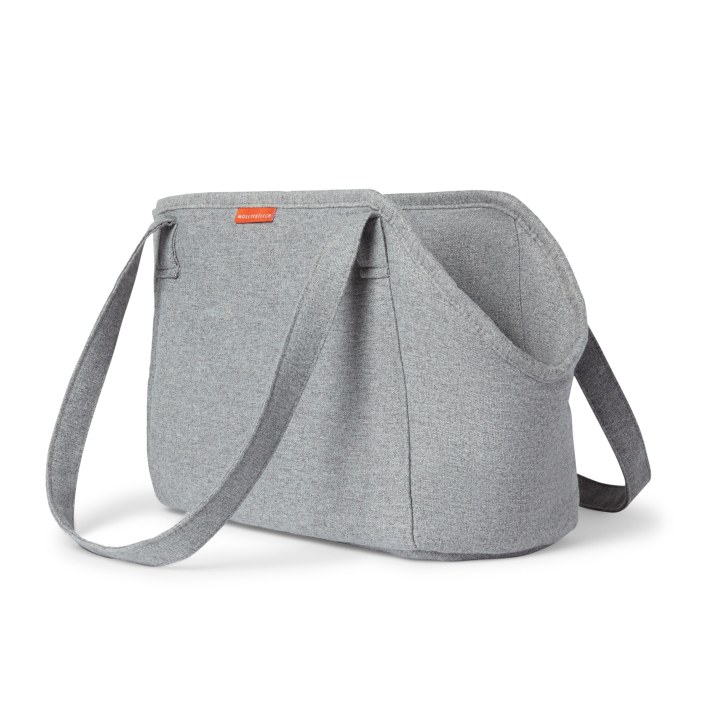
Molly and Stitch Alpine Dog Carrier
- Stylish design
- Padded and comfortable
- Machine-washable
- Not for plane travel
This tote carrier is great for smaller dogs, and its lightweight design is convenient to take anywhere. It's a favorite of NBC Select social commerce editor Sadhana Daruvuri, who says her 2-year-old maltipoo Bandit fits comfortably inside. “This carrier is very high quality, and it was so stylish that I would happily use it as an everyday bag,” says Daruvuri. “Cleaning it is also easy — you can just throw it in the wash, and even after repeated uses, the bag looks brand new.”
Pet weight: Up to 15 lbs | Dimensions: n/a | Material: n/a
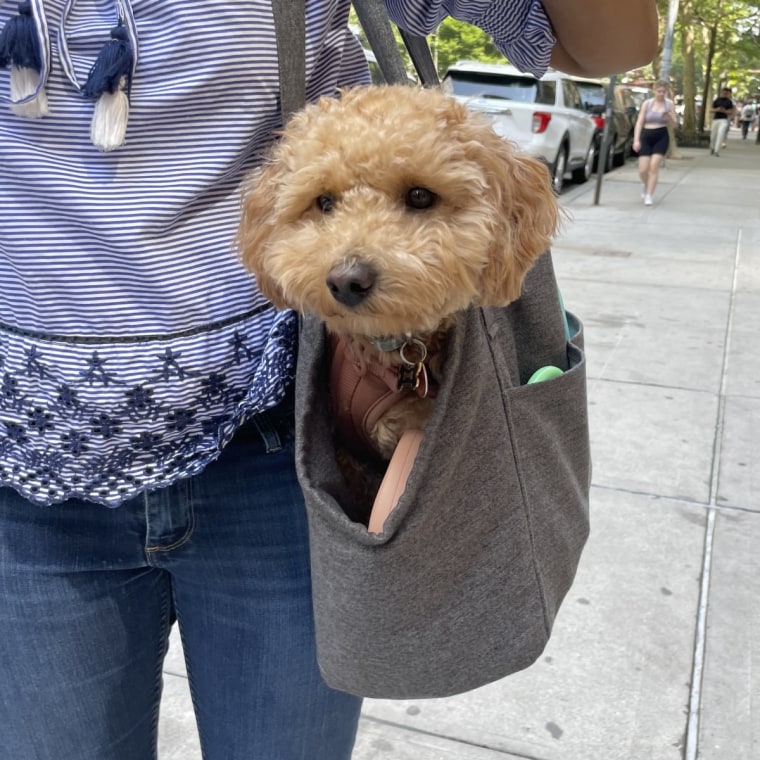
Best carrier with pee pad: Diggs Passenger Travel Carrier
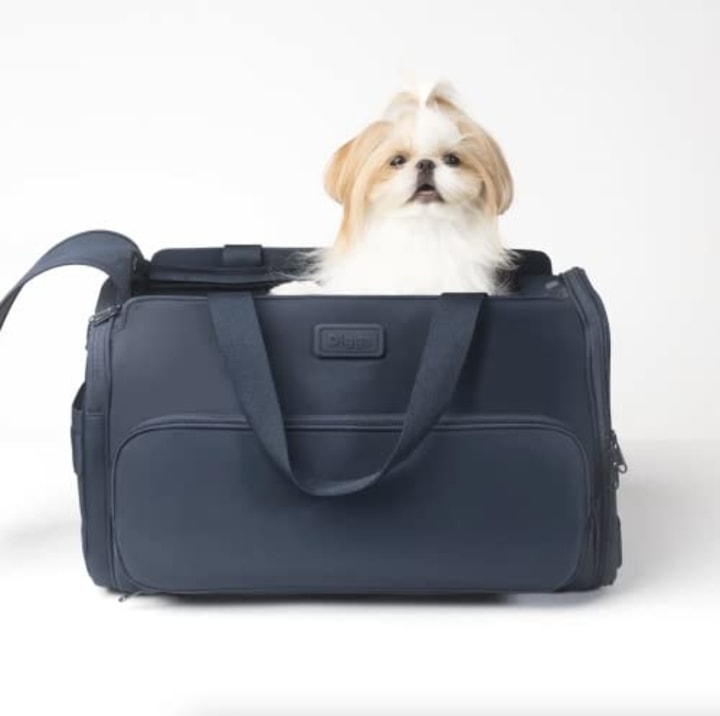
Diggs Passenger Travel Carrier
- Includes a bed and pee pad
- Has multiple pocket
- Not as much mesh as others
Diggs is an NBC Select Pet Award -winning brand that makes some of our favorite dog crates. The brand’s Passenger Travel Carrier is great for both plane and car travel: It fits many airlines’ size requirements, and it has custom seat belt clips and a buckle strap to place it safely in your car. It also comes with a Diggs Pee Pad that attaches to the included bed — if your dog chooses to use it, you can open the side panel to swap it out without disrupting your pup, according to the brand.
Pet weight: Up to 18 lbs | Dimensions: 20 x 11.5 x 10.8 | Material: n/a
Best personalizable carrier: Paravel Cabana Pet Carrier
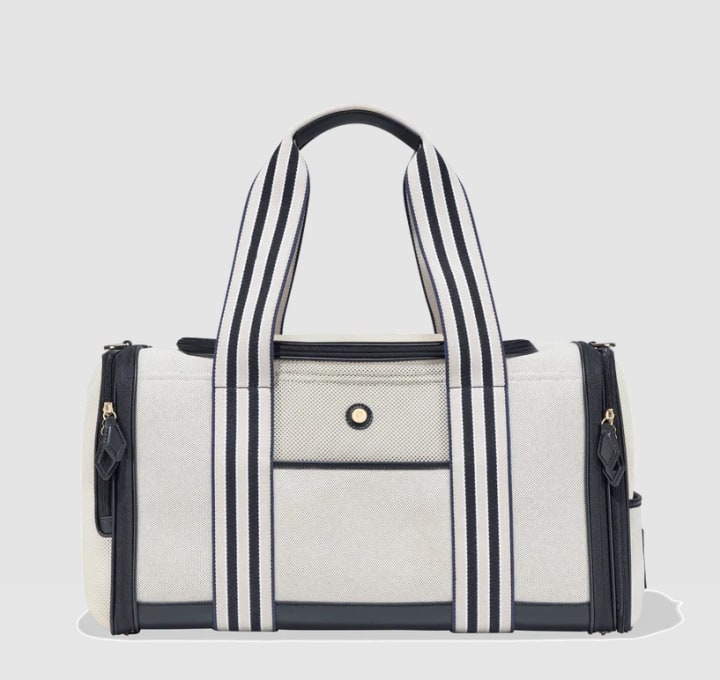
Paravel Cabana Carrier
- Personalizable with name
- Folds flat for easy storage
If you’re looking for a personalized option, this Paravel pet carrier — which is the dog-friendly version of the brand’s original Cabana Tote — lets you monogram your pup’s name or initials in the color of your choosing. It also has a washable fleece interior lining, comes with several pockets for storing treats and other small essentials, and it folds completely flat for easy storage.
Pet weight: Up to 20 lbs | Dimensions: 11 x 20.5 x 11 in. | Material: Paravel EcoCraft Canvas, vegan leather
Best sling carrier: Tomkas Dog Sling Carrier
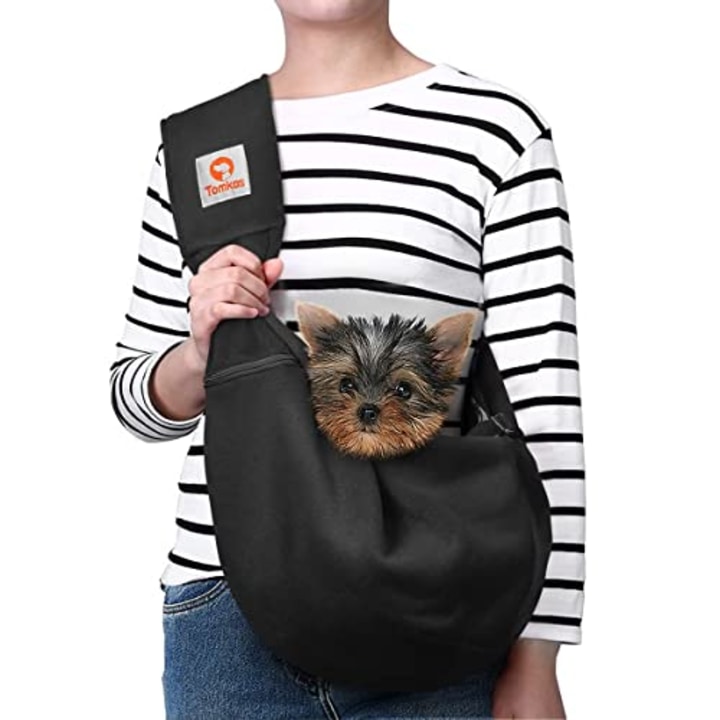
Tomkas Dog Sling Carrier
- Easy to take on the go
- Zip pockets for small items
- Requires physical strength
Designed for small dogs up to 10 pounds, this sling carrier crosses over your body so you can take your dog around town hands-free. The base has a built-in drawstring that adjusts the size of the opening to fit different sized dogs, and the crossbody strap length is also adjustable to fit your comfort level. The carrier includes a safety buckle inside that connects to your dog’s harness to prevent them from falling out, according to the brand. I purchased this carrier for my dog Bella when she was a puppy, and I was able to comfortably carry her around when she got tired of walking. It held her weight well without tearing or damaging the fabric, and the crossbody strap caused less strain on my back.
Pet weight: Up to 10 lbs | Dimensions: 9 x 6 x 3 in. | Material: Polyester
How to shop for a dog travel carrier
Carriers and crates are the most secure type of enclosure when traveling with your dog because they prevent them from escaping and minimize distraction while you’re traveling (especially while driving), says Wolko. But the right carrier for your dog will depend on what type of trip you’re taking, your method of transportation and their temperament.
When shopping for the right carrier for your dog, our experts recommend considering the size and fit of the enclosure, whether it’s crash-tested, if it meets airline requirements and more.
Your dog or cat should be able to easily stand up, turn around and lay comfortably in their carrier. That means the length of your carrier from front to back should measure about the same, or one or two inches more than the tip of your dog’s nose to the base of their tail, says Nelson. You should add a few more inches for brachycephalic breeds like pugs, pekingese and French bulldogs, though experts don’t recommend taking these breeds on flights because their shorter noses increase the risk of overheating and oxygen deprivation, says Nelson (some airlines even ban this breed from flying in the cargo hold , according to the American Veterinary Medical Association). To determine the right height of your carrier, make sure it measures the same or larger than the height of your pet from the floor to the top of their shoulders, says Carlo.
Place a mat or bed in the carrier to make the space more comfortable for your pet, says Carlo (though you should avoid this if your dog usually destroys their bedding because they might eat the pieces and cause intestinal obstruction). Putting soft blankets or their favorite toy in the carrier can also help them feel familiar and safe, according to our experts.
Whether your dog can see out of their carrier is a matter of personal preference, though our experts recommend mesh so the outside is visible, which prevents your dog from feeling threatened or confused while they’re traveling, says Wolko.
Materials and structure
Most carriers are soft-sided and made from materials like polyester, mesh and nylon fabric. Consider whether the carrier has structure, meaning it can stand up on its own and won’t automatically collapse around your pet, according to Carlo. You should also look for carriers that have pockets, so you have room for your pet supplies.
You can take a hard-sided, non-collapsible crate or kennel on an airplane, but they must be able to fit under the passenger’s seat, according to Hauser (this might be harder to do compared to soft-sided carriers since they don’t mold to a different size). Plastic hard-sided crates are usually good for transporting your pet in an airplane cargo hold and the cargo area of a car — they’re considered to be the safest option since they won’t lose their shape and provide impact protection in case of a crash, turbulence or hard fall, according to our experts. However, you should avoid metal wire crates because pets might be able to stick their feet or limbs out, which can be a safety hazard while traveling, says Karwacki.
Safety considerations
For car travel, look for carriers and crates that have undergone crash testing by the Center for Pet Safety, a registered nonprofit and advocacy organization that crash tests car restraints and containment devices. This provides an extra layer of safety when traveling with your pet, our experts say.
“Most carriers on the market only prevent distractions [for the driver], which is important, but in a crash, they may not perform as you would expect them to,” says Wolko. The CPS certification tests carriers as an unaffiliated third party. This is important when considering that many brands subjectively “pass” their carriers if they test them in their own labs, which can ultimately give pet owners a false sense of security, according to Wolko.
Though the CPS does not specifically test carriers and crates for airline travel, you can use most carriers that meet the airline’s size requirements and have ample ventilation, according to Wolko.
A CPS-certified crate usually has backup door latches and locking mechanisms to prevent your pet from escaping, which is especially useful if they travel in the aircraft’s cargo hold. “So, if something tumbles, the kennel is so robust that the pet is not getting out,” says Wolko. Most airlines have certain regulations for what carriers to use when transporting an animal in the cargo area of a plane. The International Air Transport Association, a globally recognized trade association for the world’s airlines, details specific requirements for crates to transport animals in the cargo hold, including construction and adequate ventilation (more on that below).
Frequently Asked Questions
For air travel, always check with your airline to see what type and size of carrier it allows. The approved dimensions of your carrier vary from airline to airline but, in most cases, carriers can’t exceed 11 inches in height, which allows it to fit under the seat in front of the passenger, according to Hauser. Also, the carrier will likely count as your carry-on luggage on most airlines, and in-cabin travel will usually require you to make a reservation or reserve a seat specifically for your dog.
Certain airlines might also have specific pet size and weight requirements for in-cabin travel. Typically, pets must weigh 20 pounds or less, though this varies by airline, and most larger dogs can’t ride in-cabin unless they’re a trained service animal, says Wolko. If your pet exceeds that limit, they’ll need to travel in the cargo area of the plane.
Most airlines will allow trained service dogs on board at no cost. However, some airlines like Delta Air Lines, Southwest, American Airlines and Alaska Air are no longer accepting emotional support animals on board.
Carriers and crates for dogs are usually used interchangeably, but there are a few key differences. The CPS defines crates as enclosures that are secured in the cargo area of a plane or tethered securely to the floor of a vehicle like a van or SUV. They’re usually constructed of thick molded plastic or metal and designed for larger dogs, according to our experts.
Carriers, on the other hand, are usually designed for smaller dogs and made of a soft-sided fabric (though some are constructed of a harder plastic or nylon to prevent them from collapsing on your pet). When traveling in a car, the carrier usually goes in the backseat and is strapped in using the seatbelt system of your vehicle.
Yes, it is generally safe and common to travel with your dog in the cargo hold (also known as the lower deck) of an airplane, which also holds baggage. However, experts recommend only flying your pet in the cargo hold when it’s absolutely necessary because it can be a very stressful experience for them.
“There’s a lot of weird noises, not much light down there — it’d be scary for anyone to go in the [cargo hold], ” says Karwacki. And, most handling risks come before they even board the plane: Dogs usually endure the most force when being transported across the rough, uneven tarmac to get to the plane, says Wolko.
The International Air Transport Association (IATA) lists specific requirements for crates, including construction and ventilation, to keep your pet safe when flying in the cargo hold. For example, the trade association specifies that crates must be sturdy and inescapable and adequately ventilated on three sides, with the majority of the ventilation being provided on the upper part of the container.
Most aircraft cargo holds are temperature-controlled and pressurized, according to the U.S. Department of Agriculture . Animals can’t be exposed to temperatures above 85 degrees Fahrenheit or below 45 degrees Fahrenheit for more than 4 hours, per the USDA’s website. Most airlines won’t transport dogs altogether if ground temperatures reach those extremes.
How to help your dog feel calm in a travel carrier
Your pet’s comfort level in their carrier can determine how smooth your travels are. Below, we list a few expert tips about how to get your dog adjusted to their carrier and how to keep them comfortable during long trips.
- Know your dog’s safety and security preferences. Some dogs prefer more open-sided kennels with better airflow and visibility, while others feel safer with the cave-like security of a molded plastic carrier with smaller windows, says Hauser.
- Make the carrier or crate their “happy spot.” Allowing your pet to build a positive association with their carrier helps them feel calm and safe while traveling, according to our experts. In your home and before traveling, leave the door open so that your pup can explore the enclosure on their own terms, which demystifies it, says Hauser. After some time, it isn’t uncommon to find pets that preferentially sleep in their enclosures,” she says. Once they get acclimated to the crate or carrier at home, you can then graduate to car trips and, later on, plane rides. Start off with brief trips that increase in duration over time.
- Make the carrier feel familiar. As we mentioned, putting their favorite bed, blankets or toys in the carrier can help make them feel more comfortable.
- Avoid any safety risks while on the plane. For example, if you’re traveling with your pet in-cabin, never put the carrier in the overhead compartment of the plane with your pet inside because it poses a suffocation risk, says Wolko. Also, feed your pet before you get on the plane — if they choke or get something lodged in their throat while you’re in the air, they likely won’t get help in time, according to Wolko.
Meet our experts
At NBC Select, we work with experts who have specialized knowledge and authority based on relevant training and/or experience. We also take steps to ensure all expert advice and recommendations are made independently and without undisclosed financial conflicts of interest.
- Dr. Kristen L. Nelson is a veterinarian and author of “Coated With Fur: A Vet’s Life.”
- Dr. Christina Carlo is a veterinarian and medical director at VCA Avondale Veterinary Hospital.
- Dr. Wendy Hauser is a veterinarian and special advisor to ASPCA Pet Health Insurance.
- Lindsey Wolko is the founder of the Center for Pet Safety , a registered nonprofit and advocacy organization that crash-tests car restraints and containment devices for pets.
- Dr. Amber Karwacki is a veterinarian and partner doctor at Heart + Paw in Callowhill, Pennsylvania.
Why trust NBC Select?
Mili Godio is an updates editor at NBC Select who covers a variety of pet topics, including dog food , beds , treats and toys . For this article, Godio spoke to five veterinarians and pet safety experts about the best carriers for your dog and how to safely travel with them. She also compiled experts' recommendations for the best travel carriers to consider, as well as travel carriers tested and reviewed by NBC Select staff.
Catch up on NBC Select’s in-depth coverage of personal finance , tech and tools , wellness and more, and follow us on Facebook , Instagram , Twitter and TikTok to stay up to date.
Mili Godio is an updates editor for Select on NBC News.

IMAGES
VIDEO
COMMENTS
It is advised to consult with a Copperas Cove child protective services attorney to protect your rights and childproof your house. Speak with our experienced CPS attorney in Copperas Cove, Texas, to discuss your situation and to find out what CPS may look for when inspecting your home. Call us at (254) 781-4222 or contact us online for a FREE ...
Bedrooms. Many families are surprised to learn that when it comes to "What does CPS look for in a home visit?" the answer is always "sleeping arrangements.". Even if your complaint has nothing to do with a child's sleeping arrangement, this issue will most likely be addressed by your caseworker.
A CPS home visit checklist helps ensure that you address everything Child Protective Services (CPS) considers important to children's safety. CPS is a division of the Department of Social Services that responds to allegations of child abuse, neglect, or similar. The first thing a CPS home visit checklist checks for is signs of abuse or neglect.
Once there is an allegation of family violence, it is the obligation of the CPS team to ensure the safety of the child. Your case will be investigated by a member of the CPS team. She is a social worker whose only priority is your child. A CPS worker is generally called for a routine 'welfare check' after an incident of domestic violence.
The following statements must be answered YES, unless not applicable or an exception is granted, to approve the home for placement. (a)(1) No more than 2 children share a bedroom. (a)(2) No sharing a bedroom by children of opposite sex unless each child is under 5 years of age. (a)(2)(A) A minor parent may share a bedroom with the minor parent ...
The CPS Home Visit Checklist Template can help children and minors feel safe and provided for within their home environments. These instances may encompass the following: Cases of abuse or neglect: In most reports of child abuse or misconduct in home environments, CPS agents are required to check out the homes to verify the claims.
Any medication apparatus is a red flag. Second-hand smoke includes the home is also something the CPS will pay attention to, especially if the children have inhale or other lung problems. Method for Preparation a CPS Home Visit With Checklist. Environmental Peril. When, older and cheaper homes can is quite dangerous.
Many people wonder, "What does CPS look for in a home visit?". The major factors are making sure the home is a safe place for the child. For example, they look at the quality of the sleeping conditions, how much food is available, and if the child has enough clothing to determine if there's any sign of neglect.
Our priority at Cronkright Law is to protect your best interests and fight to keep your children at home with you. Put our expertise on your side. Do not hesitate to call our experienced attorneys at (517) 881-4643 for a free, initial consultation! Learn how to prepare your home for a CPS visit on our site or call Cronkright Law today.
CPS investigators can simplify their home visits by using a digital home visit checklist via an app. Learn more about the advantages of a mobile tool. ... CPS will take note of all these things during a home visit. What Child Protective Services Looks for When Inspecting a Home. The good news is that the agency may be able to provide help ...
THE HOME VISIT CHECKLIST Before the Visit: o Set up appointment by letter or phone. o Check for current Medi-Cal eligibility in Meds. o Prepare paperwork packet - check if income eligible or status eligible. This will tell you what kind of forms you will need. o Make sure you have the Health Care Certification Form (SOC 873) for the consumer to
This digital home visit checklist covers the patient's immobility, nutrition, home environment, other people, medications, examination, safety, spiritual health, and other services needed (INHOMESSS). Used with SafetyCulture (formerly iAuditor) on a mobile device, this home visit checklist allows you to: Make notes on corresponding areas of ...
Conduct both announced and unannounced home visits. If you are doing a joint visit, plan with your co-visitor before you go on who will do each task and/or take the lead. Before your visit, plan the purpose of your visit. Find out if there are any racial/ethnicity/cultural issues and plan your visit accordingly.
5 Things Social Workers Look For During a Home Visit. Aside from ensuring the family dynamic is stable and safe, your CPS will also look for some other things. Your CPS social worker will need some space and a distraction-free area to speak with you. Make sure you have a space set up for this interview. While interviewing you, your social ...
The following digital CPS home visit checklist helps the inspector step by step to take care of all points and to evaluate them according to the requirements of the authority. With Lumiform's digital tool, there is also the possibility to work with parents on inspection issues that need to be improved. To do this, actions are triggered and ...
Child Protective Services takes its role very seriously in investigating child abuse or neglect reports in Texas.This includes performing home visits when a case is opened or reopened so that CPS can examine the current state of a child's living conditions.. A CPS caseworker will typically perform a checklist review of the home to help determine the severity of the alleged abuse or neglect.
7612.1 Supervisory Visits: Unannounced Home Visits. CPS October 2017. An unannounced home visit is considered complete when there has been an unscheduled face-to-face contact in the home with at least: • one primary caregiver; and • all children placed in the home who are involved in a DFPS case. An unannounced home visit must also include ...
The priority response criteria determines whether the commencement must occur within 12 or 24 hours; see PSM 712-1, CPS Intake. Commencement means to begin the investigation with any activity including, but not limited to: Review of case history. Gathering of evidence. Case planning with supervisor.
For Family Child Care Certification. To be completed by the 4-C certification specialist and the applicant/provider together during the home visit. Check "yes" or "no" for each standard, check "N/A" if a standard does not apply. * Indicates standards not required by DCF but required by 4-C policy.
A copy of the floor plans for your home, including dimensions and purpose for each room (can be hand drawn) 5 reference letters (only one family reference can be used) Copies of driver's license (s) or state-issued ID. Copies of Social Security Cards. Birth certificates of all household residents. Marriage certificate.
A Legal Perspective. When Child Protective Services inspects your home, it's a critical juncture under Texas law. For families in Texas, understanding this process is paramount. This comprehensive article delves into the legal intricacies of a CPS home inspection. We aim to guide you through each step, ensuring clarity and preparedness.
The California Home Visiting Program (CHVP) is designed for overburdened families who are at risk for Adverse Childhood Experiences (ACEs), including child maltreatment, domestic violence, substance use disorder and mental health related issues. Home visiting gives parents the tools and know-how to independently raise their children.
A home visit provides the county child welfare worker the opportunity to assess the safety of the childs living environment and facilitates the observations of family interactions. The provision of Child Protective Services, including visiting and interviewing the child in their home with the parents permission, must not infringe upon any
The CPS Home Visit Checklist is an assessment tool used by Child Protective Services (CPS) to evaluate the living environment of a child or family. The checklist typically includes items such as the condition of the home, safety of the environment, presence of drug and alcohol abuse, evidence of domestic violence, and the overall health of the ...
For an optimal experience visit our site on another browser. NBC Select presents: Pet Week 2024 Amazon's Pet Day sale Puppy checklist Kitten checklist Dog travel carriers